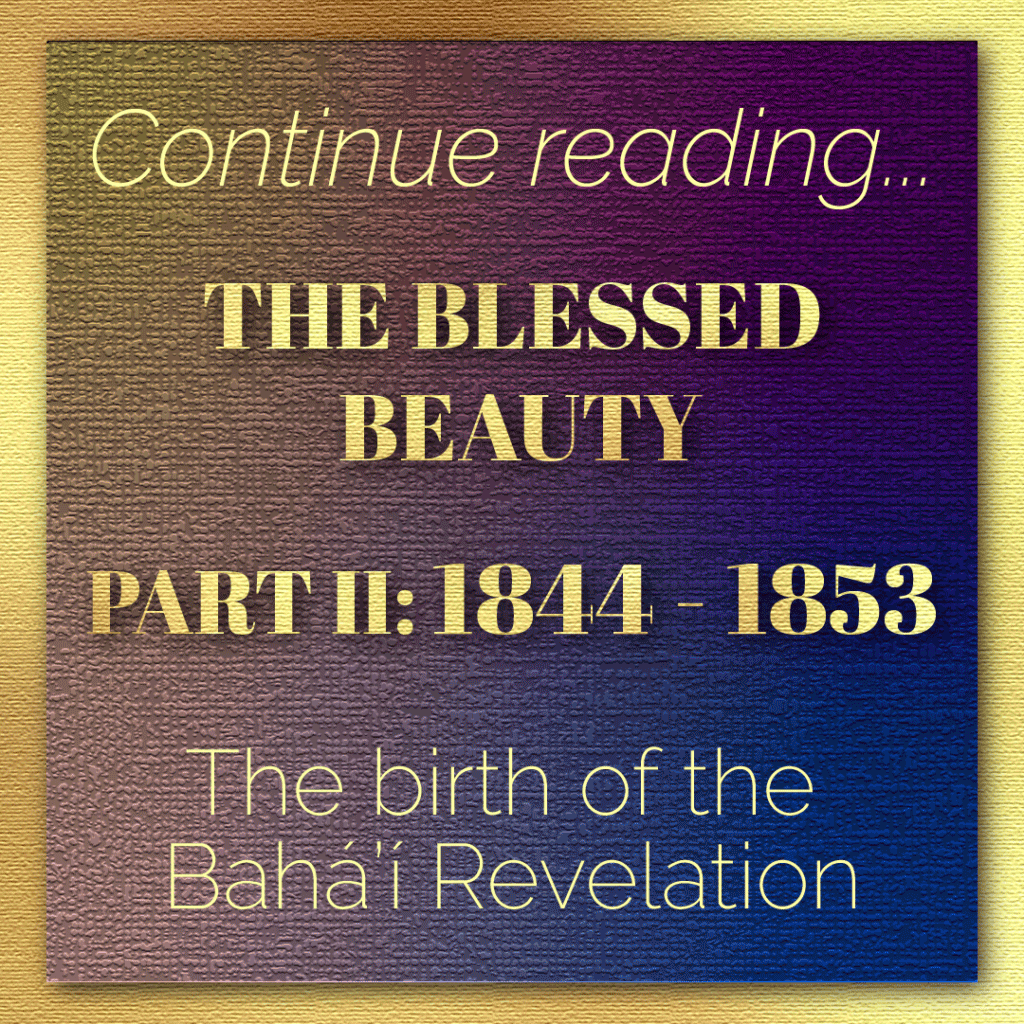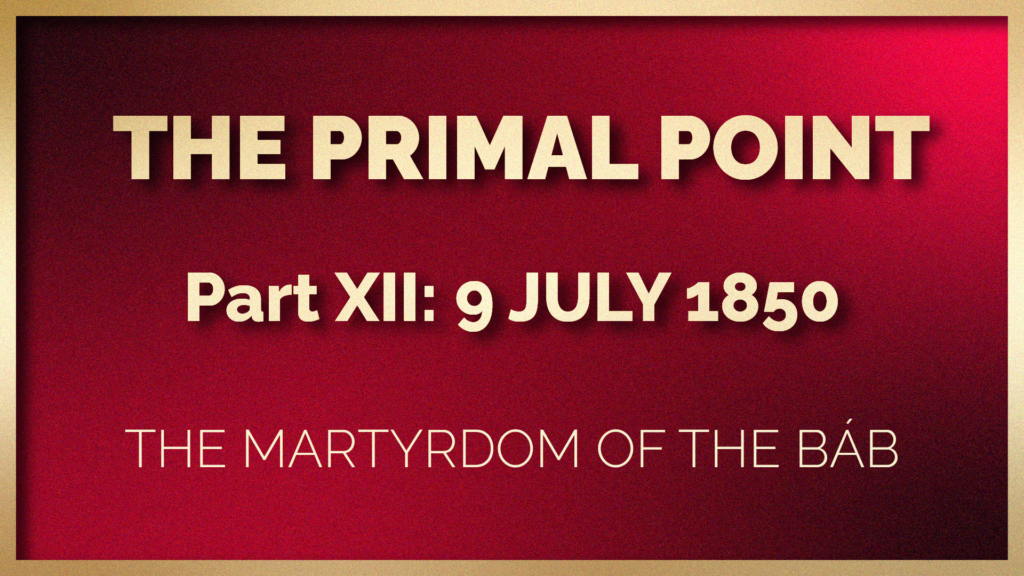
Written and illustrated by Violetta Zein
This part covers the days before, and the days, months, and years after the Martyrdom of the Báb at the age of 31 on 9 July 1850.
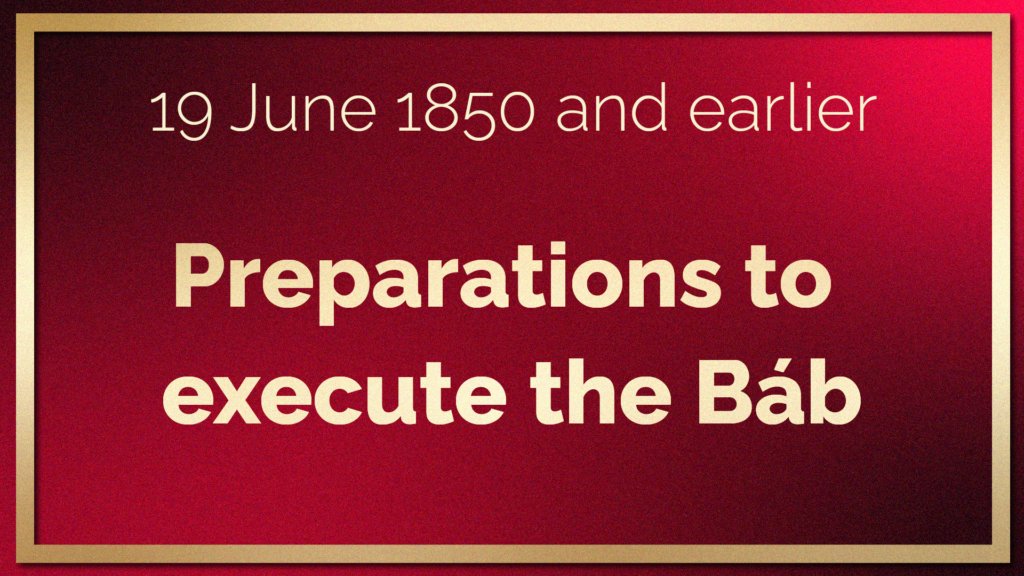

1830s photograph of Amír Kabír, or Mírzá Taqí Khán, who ordered that the Báb be executed. Original photograph: Wikimedia Commons.
Mírzá Taqí Khán, the Prime Minister, was determined to execute the Báb, convinced this was the only way to stop the progress and spread of the Bábí Faith throughout Persia.
Only the Minister of War, Áqá Khán-i-Nurí contested Mírzá Taqí Khán’s decision, pleading that to execute a descendent of the Prophet Muḥammad would be an act of cruelty. Mírzá Taqí Khán was displeased with him, and insisted:
“Nothing short of the remedy I advocate can uproot this evil and bring us the peace for which we long.”
Mírzá Taqí Khán ordered Ḥamzih Mírzá, the Governor-General of Ádharbáyján, to bring the Báb from Chihríq, and His escort took the Báb through a much longer route, through Urúmíyyih, arriving on 19 June 1850.
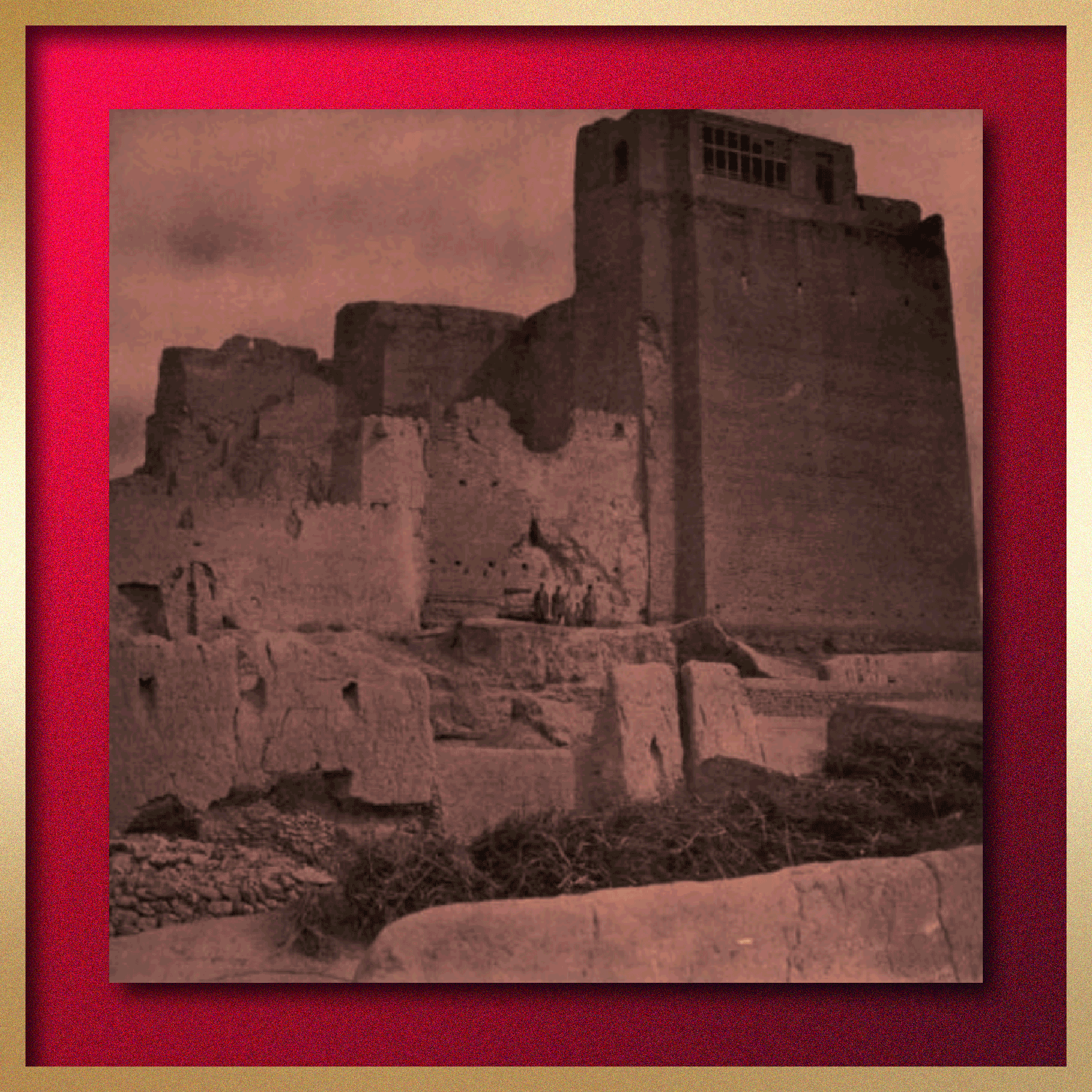
The Ark, or Citadel of Tabríz from Abraham Valentine Williams Jackson, Persia Past and Present: A Book of Travel and Research, page 41, Source: Internet Archive.
When the Báb had been brought to Tabríz, new orders came down from Mírzá Taqí Khán that the Báb was to be executed by firing squad, in full view of the population of Tabríz.
The Báb had arrived in Tabríz two months after the start of the Zanján Upheaval, and two days before the government troops crushed the Nayríz Upheaval on 21 June 1850.
Vaḥíd was savagely martyred on 1 July 1850, ten days before the Báb was executed.
The Báb would stay in Tabríz for 11 days before He was martyred.
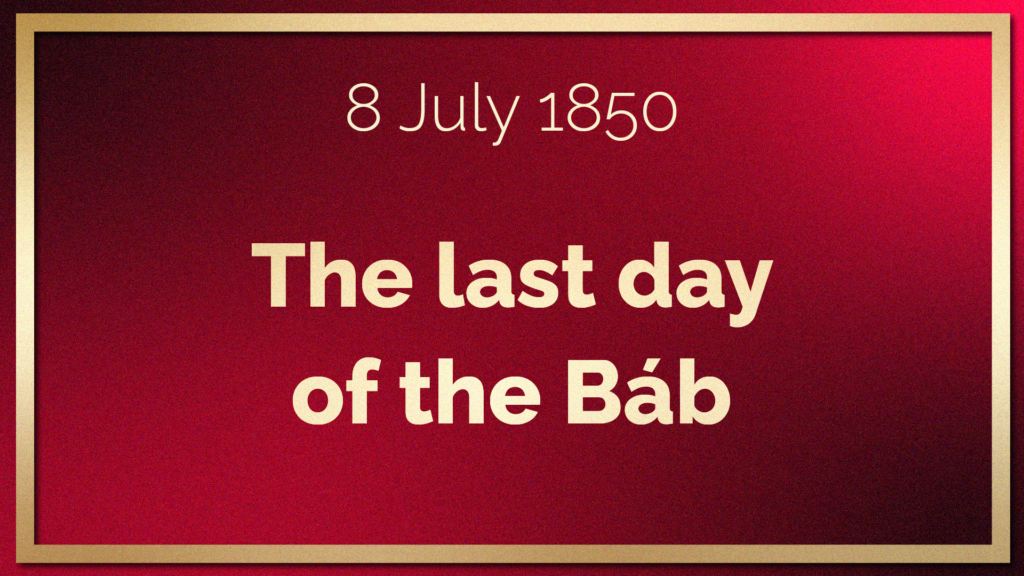
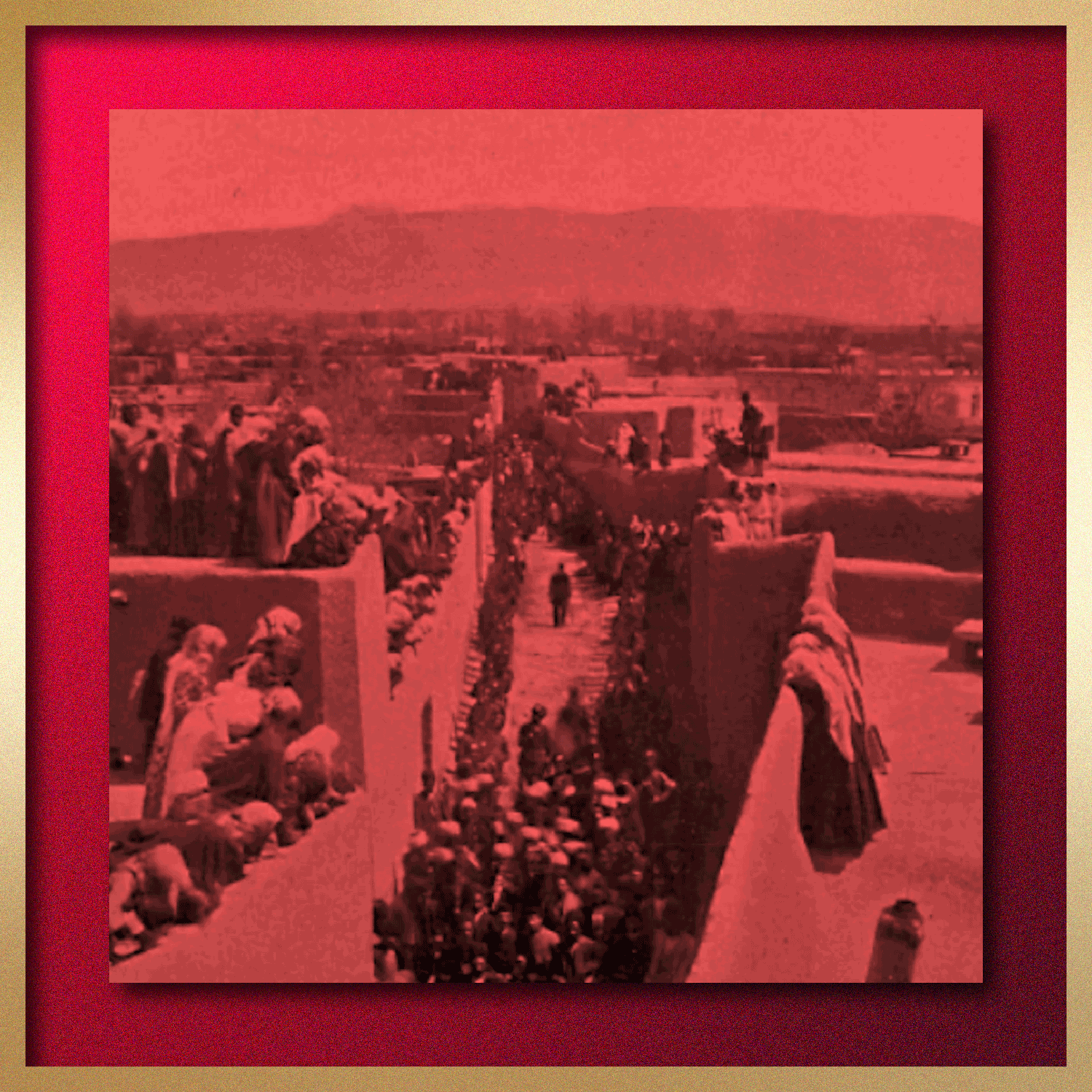
For a scene where Anís flings himself at the Báb’s feet in a street of Tabríz, the street leading to the Citadel where they will both be confined that night. Source: Bahá'í Media Bank, © Bahá'í International Community 2023.
Ḥamzih Mírzá, the Governor of Ádhirbáyján, categorically refused to be associated in any way with the execution of the Báb, stating he was not a traitor to Islám and could not be called upon to kill an innocent descendent of the Prophet Muḥammad.
When Mírzá Taqí Khán learned of Ḥamzih Mírzá’s refusal, he instructed his brother to carry out his orders.
The Báb was stripped of His sash and turban, the signs that indicated His exalted lineage, and was taken from the house the Governor had placed at His disposal to the barracks on foot.
As He made His way to the citadel through a street of Tabríz, Anís, barefoot and disheveled, threw himself at the Báb’s feet, two years after his vision where the Báb had promised him martyrdom, and begged Him:
“Send me not from Thee, O Master. Wherever Thou goest, suffer me to follow Thee.”
The Báb replied:
“Muḥammad-‘Alí, arise, and rest assured that you will be with Me. Tomorrow you shall witness what God has decreed.”
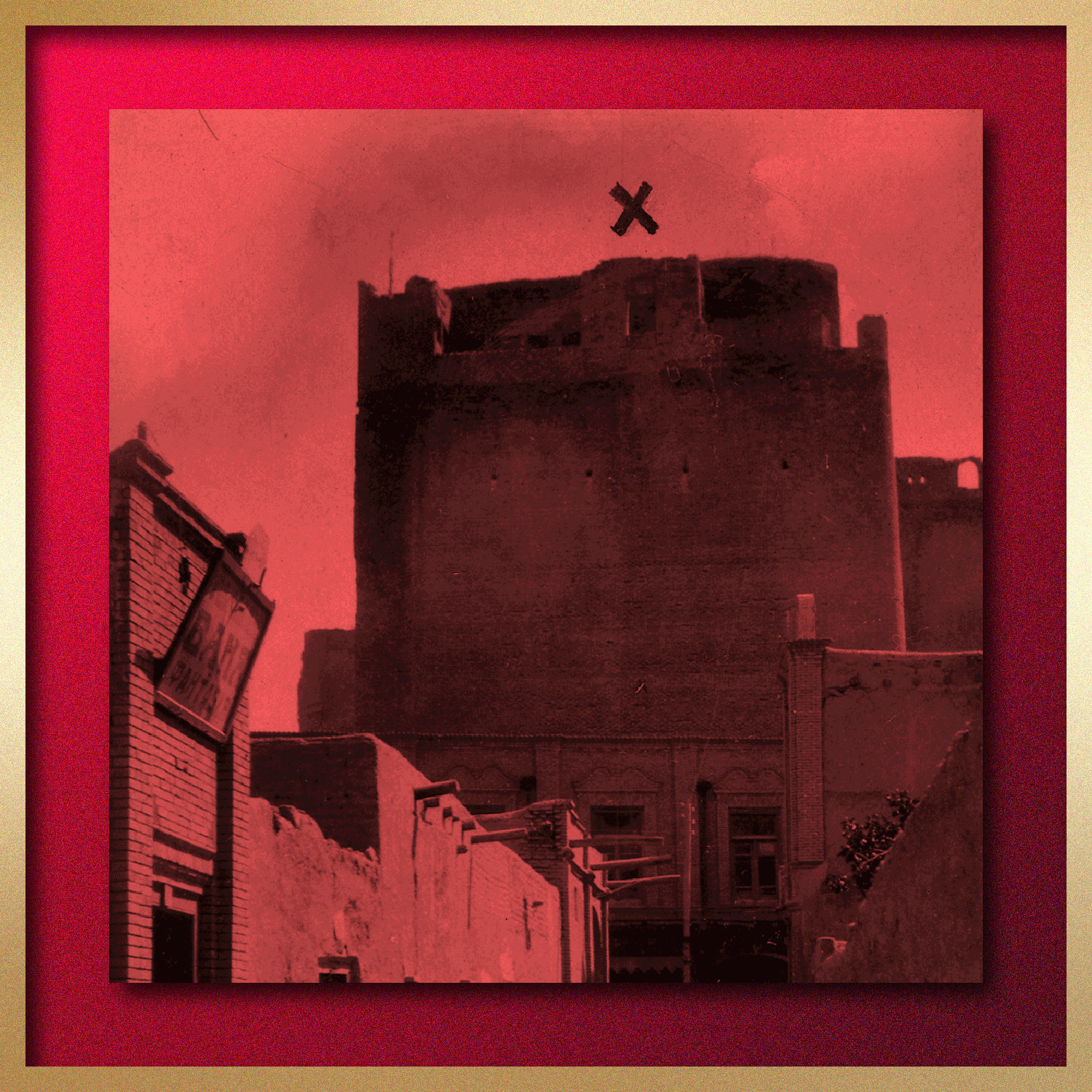
Historical view of the Citadel of Tabríz where the Báb was confined, showing the exterior (right) of the room He occupied, marked with an “X,” the very room where the story below takes place. Source: Bahá'í Media Bank, © Bahá'í International Community 2023.
The Báb was filled with joy on His last night on earth. He knew the next day that He would quaff the cup the martyrdom. He also was certain beyond the shadow of a doubt that His mission on earth had been successful, and had withstood the fierce oppositions of the Persian government and Muslim clerics alike.
He had been in constant communication, from the moment of His Declaration, with Bahá'u'lláh, “Him Whom God shall make manifest (Man-Yuẓhiruhu'lláh),” and Bahá'u'lláh was still completely safe and anonymous, free to bring His own Revelation to fruition in the next decade.
The Báb had accomplished His mission and He was content and happy. To His faithful disciples assembled with Him on this historic night, He asked the greatest favor: that one among them would offer Him the gift at dying at the hands of a friend rather than by the brutal hand of His enemies.
Only Anís rose to respond to the Báb’s request, but his companions restrained him. The Báb addressed His followers:
“This same youth who has risen to comply with My wish will together with Me, suffer martyrdom. Him will I choose to share with Me its crown.Verily Muḥammad-`Alí will be with Us in Paradise.”
The Báb instructed two of his followers, Siyyid Ḥusayn-i-Yazdí and his brother, to save their own lives by recanting their Faith so that they could carry His last words and wishes to the Bábí community.
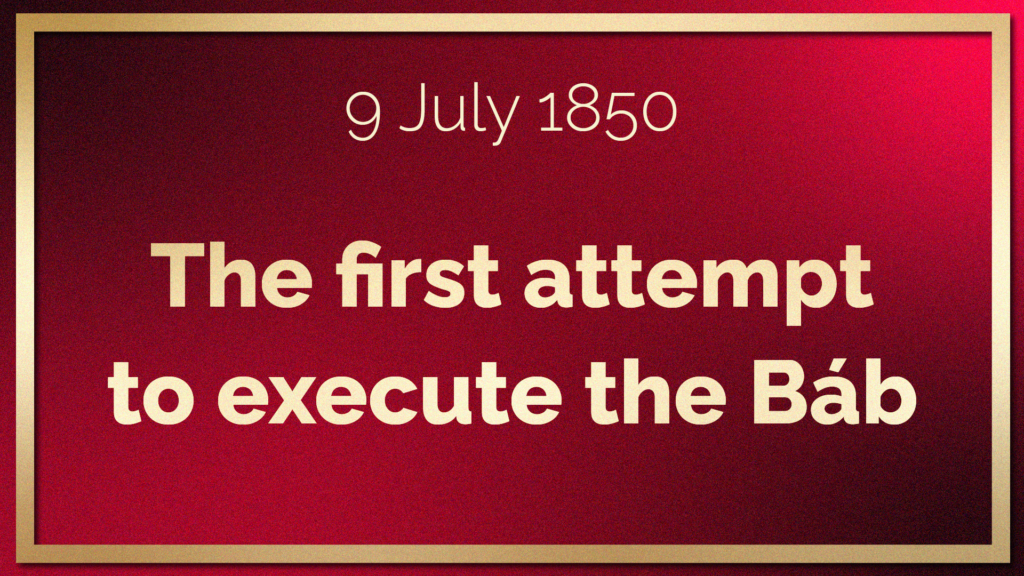
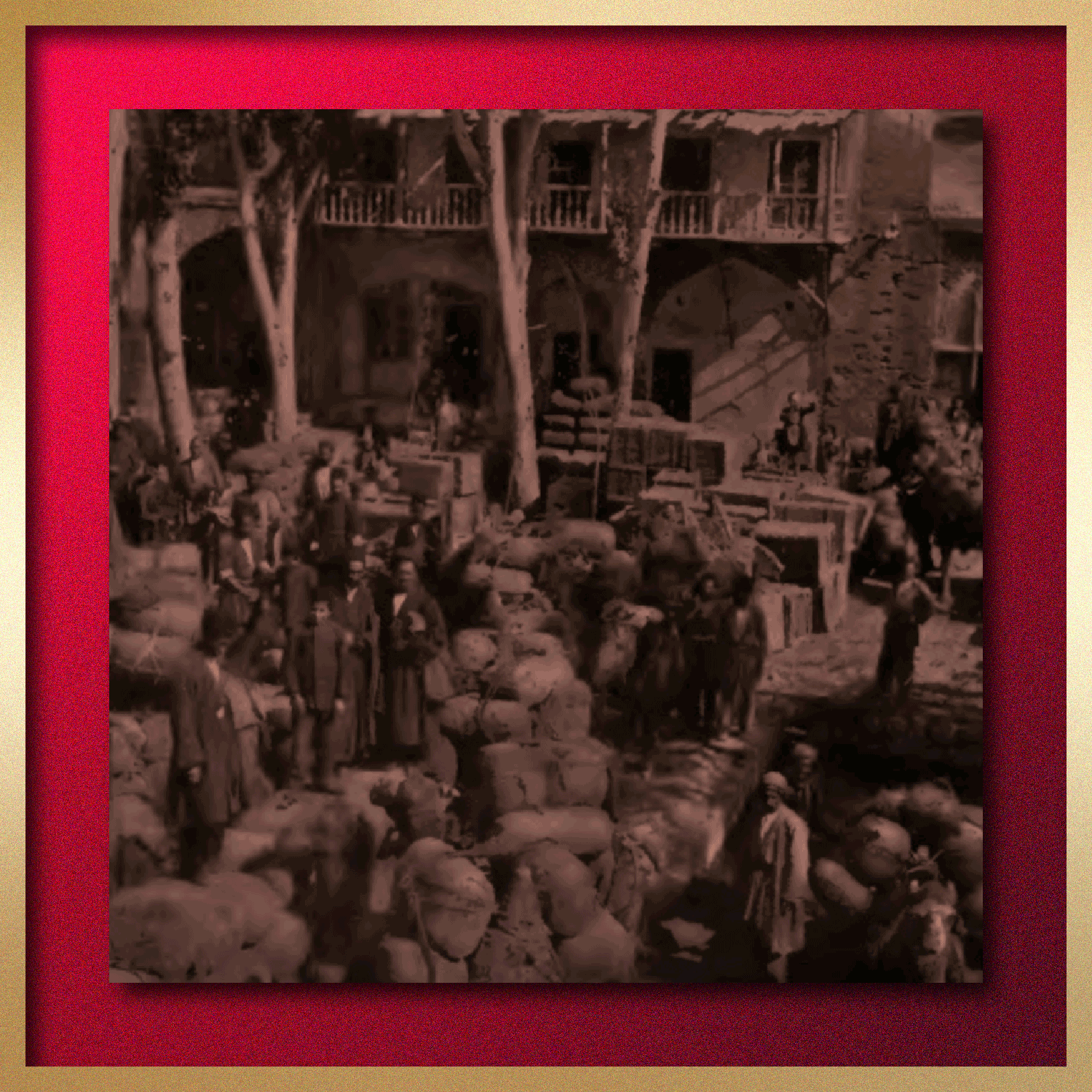
For a story where the Báb is escorted through the streets of Tabríz, a photograph of the people of Tabríz crowding a courtyard around the bazaar from Abraham Valentine Williams Jackson, Persia Past and Present: A Book of Travel and Research, page 46. Source: Internet Archive.
The next morning, 9 July 1850, the executioner rudely and abruptly interrupted a confidential conversation the Báb was having with His amanuensis, Siyyid Ḥusayn. The executioner had pulled Siyyid Ḥusayn aside and was severely reprimanding him when the Báb addressed him directly:
“Not until I have said to him all those things that I wish to say can any earthly power silence Me. Though all the world be armed against Me, yet shall it be powerless to deter Me from fulfilling, to the last word, My intention.”
The Báb was then escorted to the homes of the leading clerics of Tabríz, who had led His examination the previous year, in order to pick up the signed death-warrant, first to the houses of Mírzá Báqir and Mullá Murtiḍá-Qulíy-i-Marandí, both of whom refused to admit Him in their presence.
The Báb was then brought to the house of the most prominent of the three clerics and the leader of the Shaykhís, Mullá Muḥammad-i-Mámaqání. The Mullá seated the Báb opposite him and said:
“The confirmations of the others is not a proof for us. Furthermore, the claims that you make to the Imamate, the divine inspiration and so on can not be verified but by miracles or the confirmation of an Innocent [one of the Imáms]. If you have them, demonstrate them, otherwise you have no proof for us.”
The Báb replied:
“No, the proof is what I told you.”
Mullá Muḥammad-i-Mámaqání still continued:
“Do you still insist on the same claims that you made in our presence in the royal gathering of being the Lord of Command and having opened the gate of revelation and being capable of producing similar to the Qur’án?”
“Yes.”
“Renounce these claims, it is not proper to put yourself and other people so vainly into ruination.”
To this, the Báb responded:
“No and never.”
Anís’ stepfather tried one last time to save him, but Anís would not be separated from his destiny, refused to listen to gentle persuasion, and clearly stated his desire to be martyred with the Báb. Anís told the hateful cleric Mullá Muḥammad-i-Mámaqání to his face and with a clear mind:
“I am not mad. Such a charge should rather be brought against you who have sentenced to death a man no less holy than the promised Qá'im. He is not a fool who has embraced His Faith and is longing to shed his blood in His path.”
In a last attempt to manipulate Anís emotionally, his stepfather brought his young son to him, thinking that seeing the child might soften Anís’ resolve, but it was in vain. Anís’ faith and resolve remained unshaken, and He declared that God would provide for his boy and protect him.
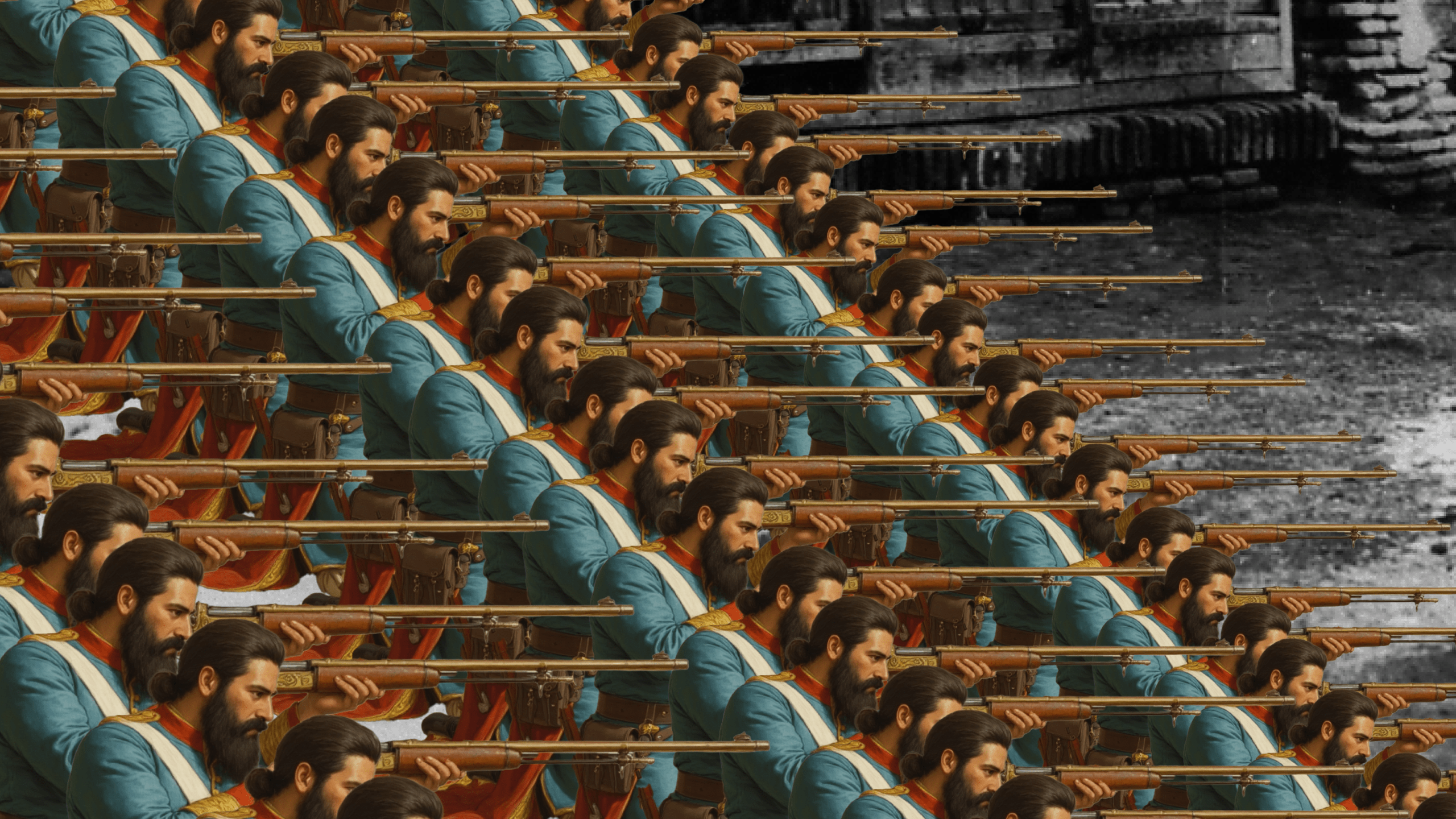
Artistic illustration created using Pikaso AI of 3 lines of an Armenian regiment in uniform.
Two hours before noon, guards led the Báb and Anís to the square in front of the citadel of Tabríz.
The executioners and guards paraded the Báb throughout the city of Tabríz barefoot and devoid of the green turban, sash and cloak, symbols of His noble lineage, as a last humiliation.
The Bahaduran regiment assigned to execute the Báb was Armenian, and the Commander, Sam Khán, was a Christian, deeply uncomfortable with his task. The Prisoner he was meant to execute looked kind and deeply compassionate, what could possibly have been His crime?
Sam Khán could not still the voice of his conscience, and he approached the Báb:
“I profess the Christian Faith and entertain no ill will against you. If your Cause be the Cause of Truth, enable me to free myself from the obligation to shed your blood.”
The Báb, in His infinite compassion, replied:
“Follow your instructions, and if your intention be sincere, the Almighty is surely able to relieve you from your perplexity.”
Guards suspended the Báb and Anís sided by side on a rope attached to spikes driven into the wall surrounding the barrack’s square. At Anís’ request, his head was laid across the Báb’s chest.
The regiment of 750 soldiers was ready, in three rows of 250 soldiers each, and the roofs of all the adjoining buildings were crowded with a huge mass of spectators.
The order was given and each row of 250 rifles fired one after the other. The smoke from so many rifles completely clouded the air, but when the smoke lifted…the Báb was no longer there!
Anís stood, alone, unconcerned and smiling, standing on the ground under the spike in the wall from which he and the Báb had been suspended just a few minutes ago. The only thing the bullets had ripped were the cords that had tied up the Báb and His companion.
“The Siyyid-i-Báb has gone from our sight!”

For a scene where the Báb is found in His cell, continuing His conversation with His amanuensis, here is a photograph of the interior of the Báb’s cell in the Citadel of Tabríz. Source: Nabil, The Dawn-Breakers, page 238.
After the Báb had disappeared from the courtyard of the barracks, there was a frantic search for Him. The Báb was found in the room where He had been earlier that day, finishing His conversation with Siyyid Ḥusayn, His amanuensis. When their conversation ended, the Báb turned to the executioner:
“I have finished My conversation with Siyyid Ḥusayn. Now you may proceed to fulfill your intention.”
The executioner remembered the words of the Báb earlier that day, when he had first interrupted the conversation, and now, terrified by the accomplishment of the Báb’s promise, he ran away and never returned to his post.
Sam Khán also remembered the words that the Báb had addressed him before he gave the order to fire on Him, and he also, made the decision that he was done trying to harm the Báb. He told his superiors he had carried out his duty and would not perform it a second time. He quit and left with his Armenian regiment and was replaced by Áqá Ján Khán-i-Khamsih and his Náṣirí soldiers.
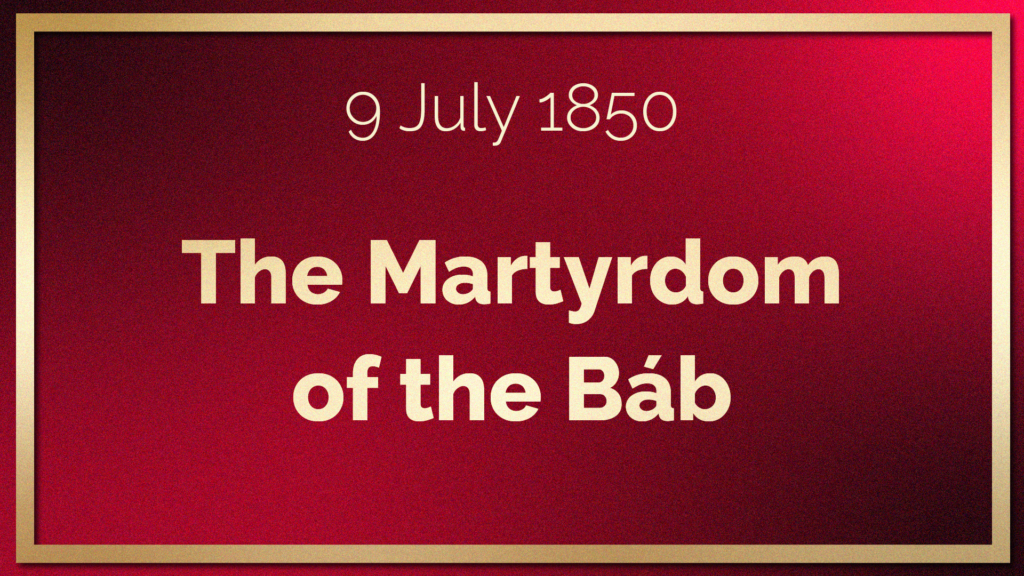

For a scene where the Báb addresses His last words to the people of Tabríz, crowded on rooftops to watch him be executed, a photograph of the people of Tabríz crowding the rooftops to watch what is happening in the street. Tabríz, in the 180s. Source: The Bahá'í Faith: The Official Website of the Worldwide Bahá'í Community: The Bábí Movement, © Bahá'í International Community, 2023.
Two hours after the first attempt to execute Him, the Báb and Anís were once again suspended from the rope and the Báb addressed His last words to the huge crowds who had amassed to watch Him die:
“Had you believed in Me, O wayward generation, every one of you would have followed the example of this youth, who stood in rank above most of you, and willingly would have sacrificed himself in My path. The day will come when you will have recognised Me; that day I shall have ceased to be with you.”
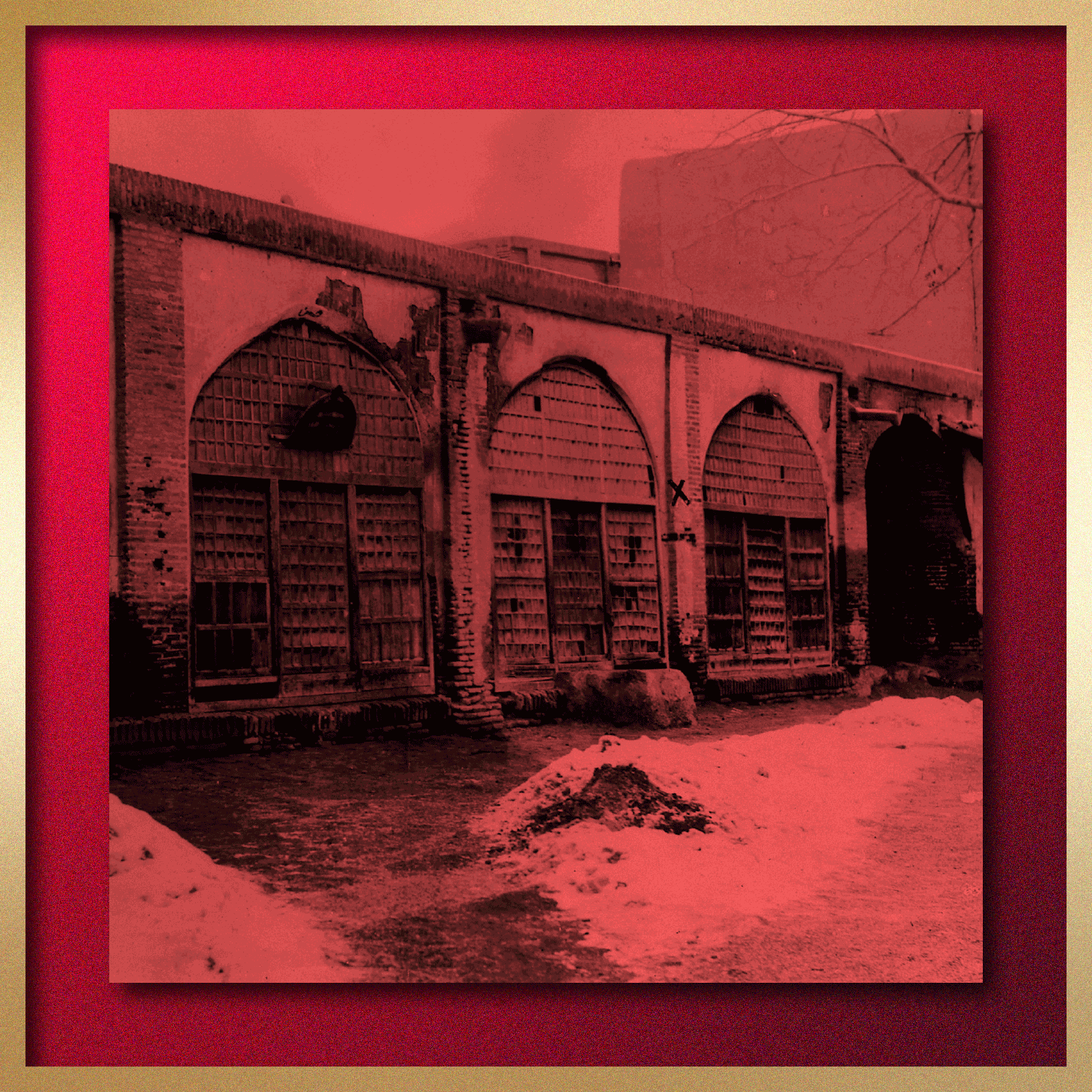
Close-up winter view of the barracks square in Tabríz where the Báb was martyred. Source: Bahá'í Media Bank, © Bahá'í International Community 2023.
The Náṣirí regiment, three rows of 250 each, fired.
The bodies of the Báb and Anís were shattered, and their remains mingled, but the face of the Báb was miraculously unscathed. Their mangled bodies were attached to a ladder and dragged through the streets of Tabríz before being thrown into a ditch outside the city walls.
The Persian Government had just executed a Manifestation of God.
The Báb was 31 years old.
These are the words of Shoghi Effendi in God Passes By regarding the martyrdom of the Báb:
“Thus ended a life which posterity will recognize as standing at the confluence of two universal prophetic cycles, the Adamic Cycle stretching back as far as the first dawnings of the world’s recorded religious history and the Bahá’í Cycle destined to propel itself across the unborn reaches of time for a period of no less than five thousand centuries. The apotheosis in which such a life attained its consummation marks, as already observed, the culmination of the most heroic phase of the Heroic Age of the Bahá’í Dispensation. It can, moreover, be regarded in no other light except as the most dramatic, the most tragic event transpiring within the entire range of the first Bahá’í century. Indeed it can be rightly acclaimed as unparalleled in the annals of the lives of all the Founders of the world’s existing religious systems.”
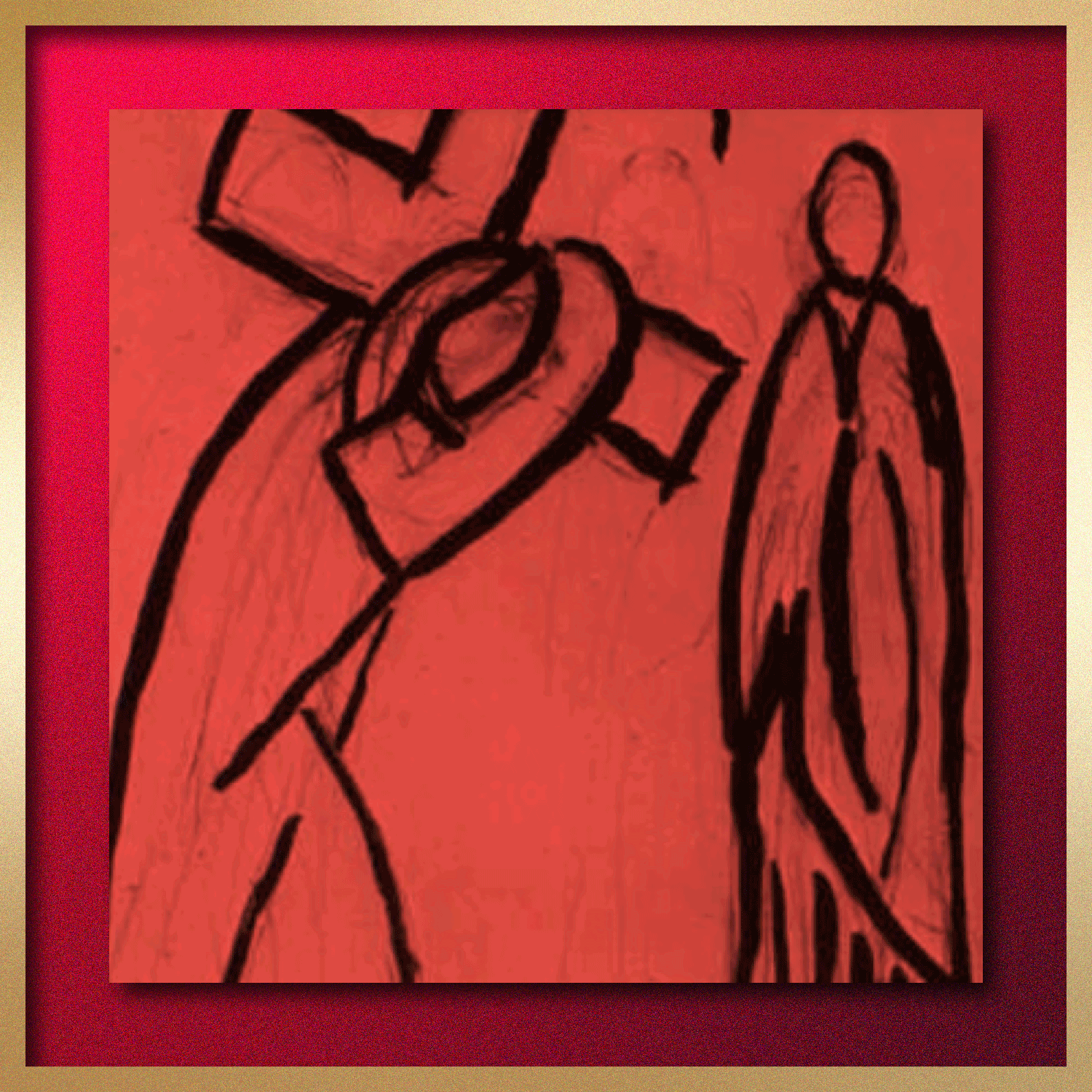
Close-up detail of a study done by Matisse for Way of the Cross mural in the Chapel of Vence, France.
Both Jesus Christ and the Báb were Manifestations of God Who were martyred by an unfair decree, at noon, almost at the same age (31 and 33), and 18 centuries apart. Both Jesus Christ and the Báb were not martyred alone, and both addressed the crowds before them, and in both cases, a storm darkened the skies after their martyrdom.
Luke 23:27-30 speaks about the address of Jesus Christ to the multitudes:
“And there followed him a great company of people, and of women, which also bewailed and lamented him.
But Jesus turning unto them said, Daughters of Jerusalem, weep not for me, but weep for yourselves, and for your children.
For, behold, the days are coming, in the which they shall say, Blessed are the barren, and the wombs that never bare, and the paps which never gave suck.
Then shall they begin to say to the mountains, Fall on us; and to the hills, Cover us.”
And later in Luke 23:44-46, we read about the storm following the noonday crucifixion (“the sixth hour”):
“And it was about the sixth hour, and there was a darkness over all the earth until the ninth hour.
And the sun was darkened, and the veil of the temple was rent in the midst.
And when Jesus had cried with a loud voice, he said, Father, into thy hands I commend my spirit: and having said thus, he gave up the ghost.”
Regarding the parallels between the ministries of the Báb and Jesus Christ, Shoghi Effendi states in God Passes By:
“The passion of Jesus Christ, and indeed His whole public ministry, alone offer a parallel to the Mission and death of the Báb, a parallel which no student of comparative religion can fail to perceive or ignore. In the youthfulness and meekness of the Inaugurator of the Bábí Dispensation; in the extreme brevity and turbulence of His public ministry; in the dramatic swiftness with which that ministry moved towards its climax; in the apostolic order which He instituted, and the primacy which He conferred on one of its members; in the boldness of His challenge to the time-honored conventions, rites and laws which had been woven into the fabric of the religion He Himself had been born into; in the rôle which an officially recognized and firmly entrenched religious hierarchy played as chief instigator of the outrages which He was made to suffer; in the indignities heaped upon Him; in the suddenness of His arrest; in the interrogation to which He was subjected; in the derision poured, and the scourging inflicted, upon Him; in the public affront He sustained; and, finally, in His ignominious suspension before the gaze of a hostile multitude—in all these we cannot fail to discern a remarkable similarity to the distinguishing features of the career of Jesus Christ.”
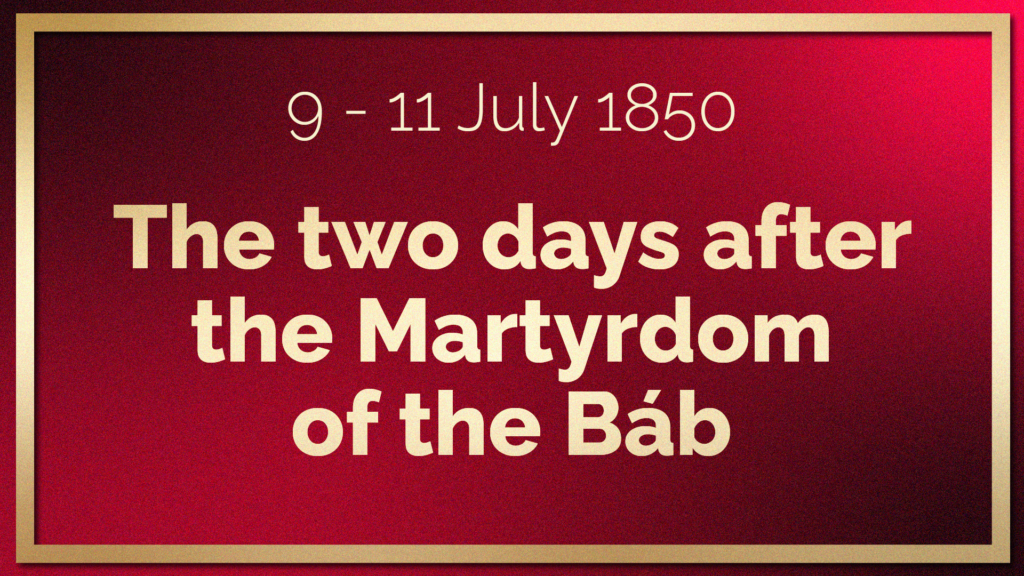
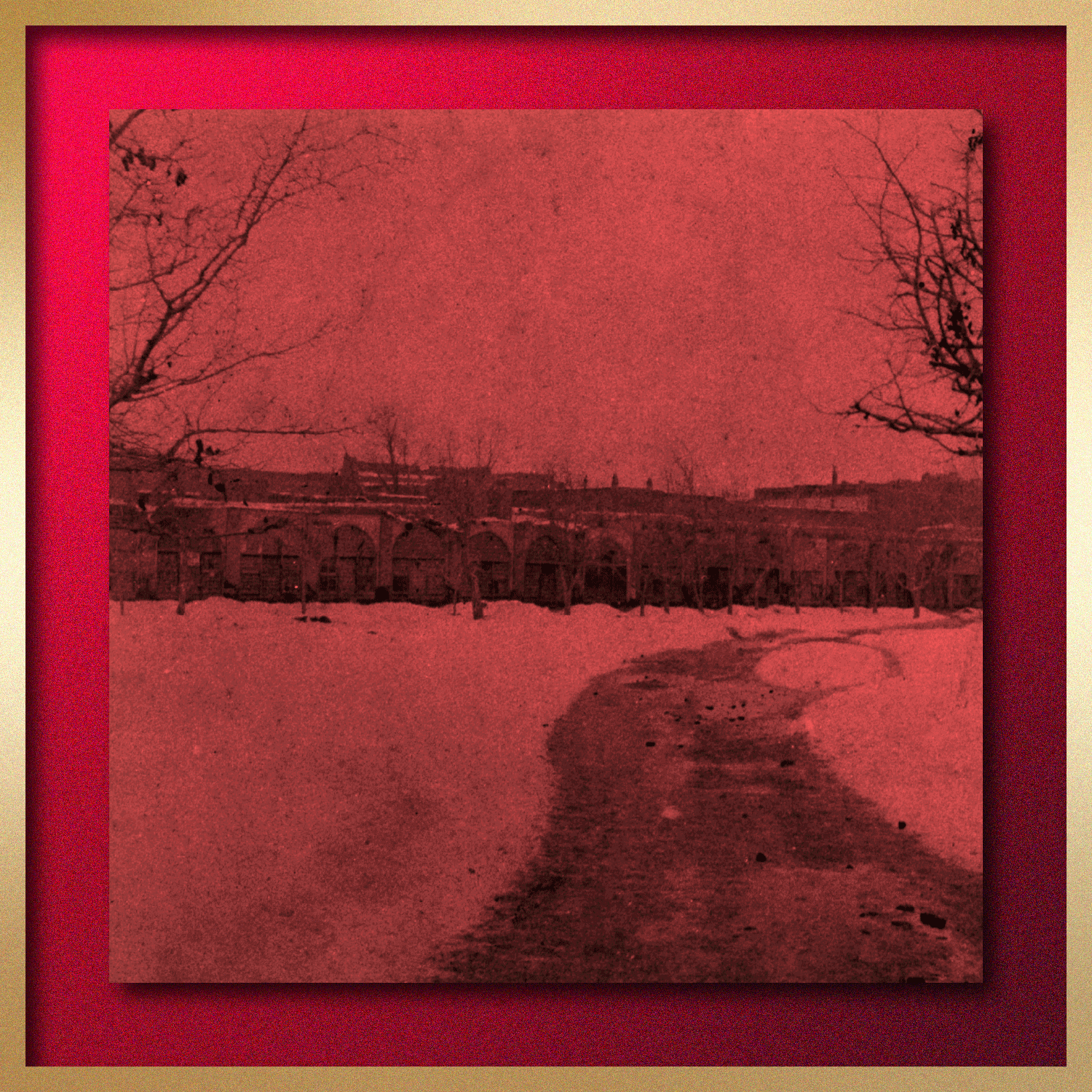
Distant view of the Barracks Square in Tabríz where the Báb was martyred. Photos taken in the dead of winter of a later year. Source: Bahá'í Media Bank, © Bahá'í International Community 2023.
As soon as the Báb had been executed, a storm descended on Tabríz, gale-force winds blew throughout the city, and dust darkened the skies and obscured the sun. Tabríz was so dark the inhabitants could not tell when night had fallen on 9 July 1850.
The guards dragged the mingled bodies of the Báb and Anís through the streets of Tabríz when night had finally fallen, and threw them on the edge of the moat that surrounded the city. Four companies, each consisting of ten sentinels, were ordered to keep watch in turn over them.
Soldiers were stationed to guard the remains from Bábís attempting to retrieve them. Not far from them, two Bábís pretending to have lost their mind, kept a watch of their own, through the night.
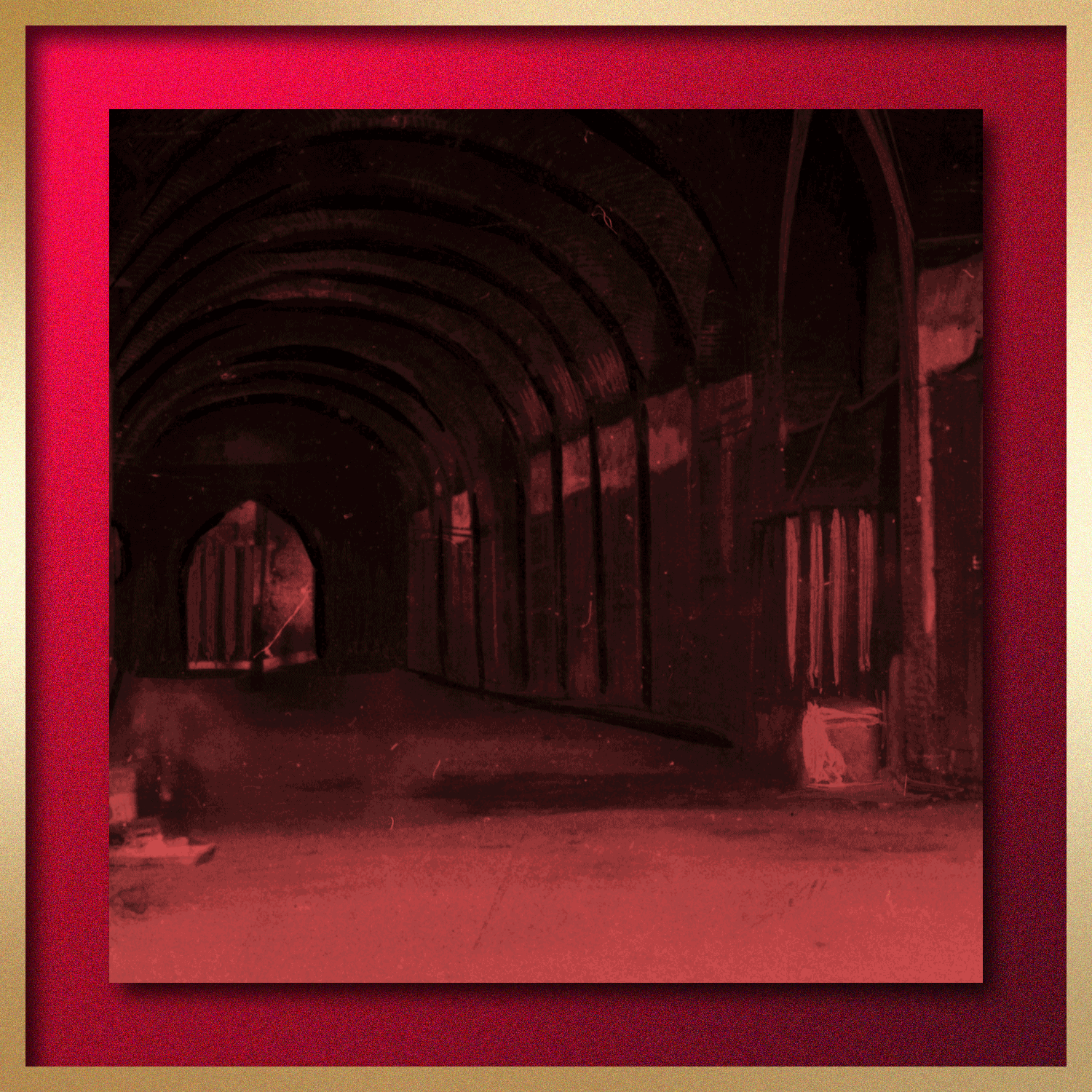
View of the site of the moat that surrounded Tabríz, where the Báb's body was thrown. Source: Bahá'í Media Bank, © Bahá'í International Community 2023.
No one knows what happened to this sketch, it has been lost, but a Bábí named Hájí ‘Alí-‘Askar had the privilege of seeing the sketch on the day it was drawn. One of the officials in the Russian consulate of Tabríz was a relative of his.
Hájí ‘Alí-‘Askar described the portrait in great detail:
“It was such a faithful portrait of the Báb that I looked upon! No bullet had struck His forehead, His cheeks, or His lips. I gazed upon a smile which seemed to be still lingering upon His countenance. His body, however, had been severely mutilated. I could recognise the arms and head of His companion, who seemed to be holding Him in his embrace. As I gazed horror-struck upon that haunting picture, and saw how those noble traits had been disfigured, my heart sank within me. I turned away my face in anguish and, regaining my house, locked myself with my room. For three days and three nights, I could neither sleep nor eat, so overwhelmed was I with emotion. That short and tumultuous life, with all its sorrows, its turmoils, its banishments, and eventually the awe-inspiring martyrdom with which it had been crowned, seemed again to be re-enacted before my eyes. I tossed upon my bed, writhing in agony and pain.”
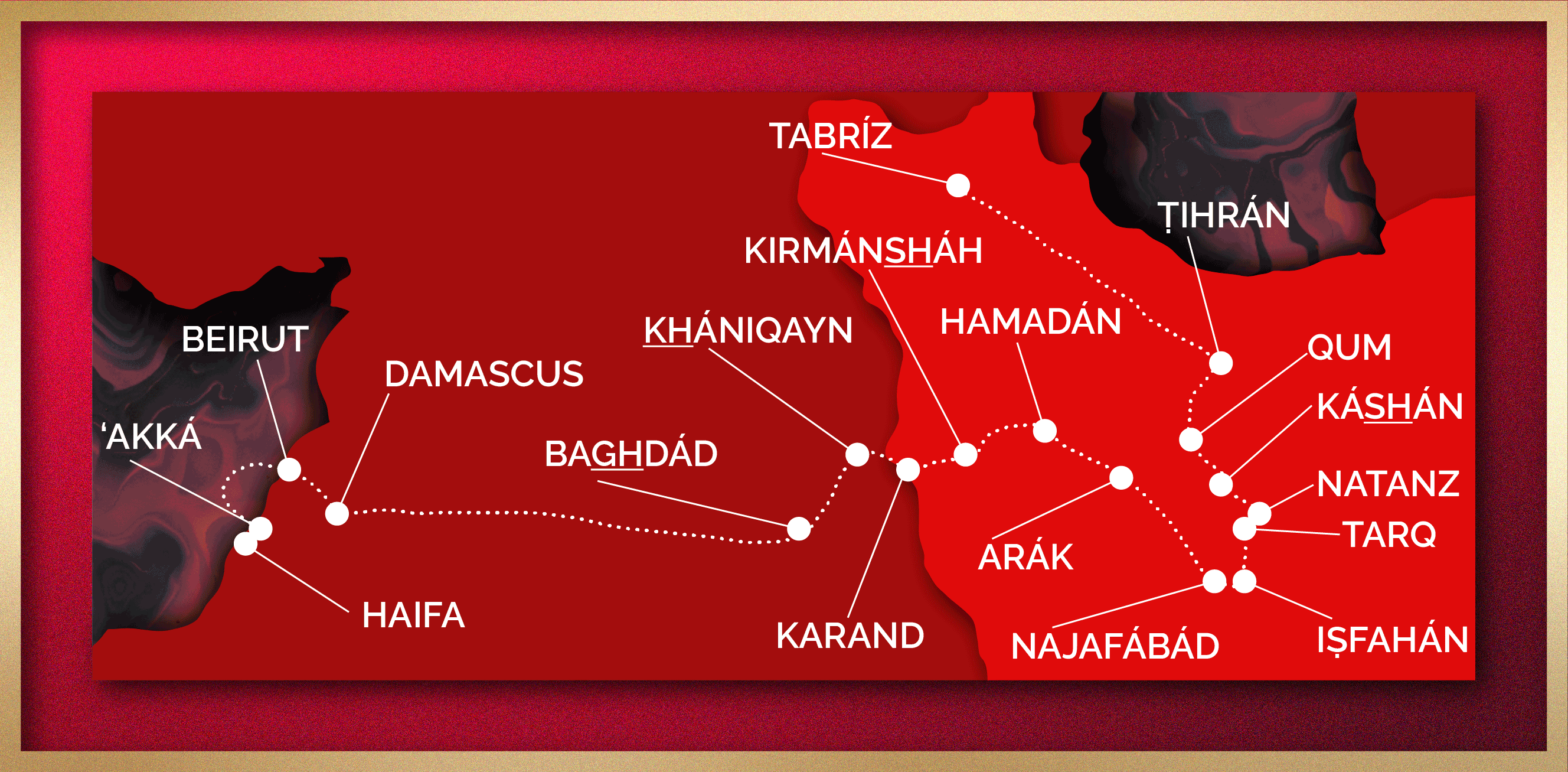
Map of the journey of the remains of the Báb during the ministries of Bahá'u'lláh (Tabríz to Ṭihrán) and that of 'Abdu'l-Bahá (Ṭihrán to Haifa) for 49 years from 1850 to 1899, when they finally arrived in the Holy Land. To read the rest of this riveting story, please see The Extraordinary Life of 'Abdu'l-Bahá: Part IV: Center of the Covenant. This map was designed based on the eight locations mentioned by Shoghi Effendi in God Passes By and additional locations listed by Michael V. Day, information found in Michael V. Day, Journey To A Mountain (The Story of the Shrine of the Bab). Map design © Violetta Zein
That same day, Sulaymán Khán, who had been blessed to meet the Báb briefly in the castle of Chihríq, arrived in Tabríz. He had come to rescue the Báb, but he arrived too late, so he went directly to the home of an old friend of his, Ḥájí Mírzá Mihdí Khán, the Mayor of Tabríz and told him that he was planning a surprise attack on the soldiers at the moat, to rescue the remains of the Báb.
The Mayor asked Sulaymán Khán to hold off on his plans until he could find a safer, more reliable, and better planned solution than a surprise attack.
Ḥájí Alláh-Yár was a close friend the Mayor, a very large and intimidating man of many talents, whose exploits were famous, and he was the one to take the Báb’s and Anis’ remains from the moat right from under the soldiers’ noses. He delivered the precious remains to Sulaymán Khán and refused to accept any payment for his immense service.
Soldiers reported the bodies had disappeared and had been devoured by wild animals. The clerics of Tabríz were overjoyed: what better proof that the Báb was not a Manifestation of God, than the fact animals would eat His remains?
Meanwhile, Sulaymán Khán moved the remains of the Báb to a silk factory belonging to a Bábí from Milán, where they were enshrouded, and hidden under bales of silk.
On 11 July 1850, a casket was built to protect the remains and send them to Ṭihrán where Bahá'u'lláh would ensure their safekeeping, and decades later, 'Abdu'l-Bahá would ensure their safe transport to the Holy Land.
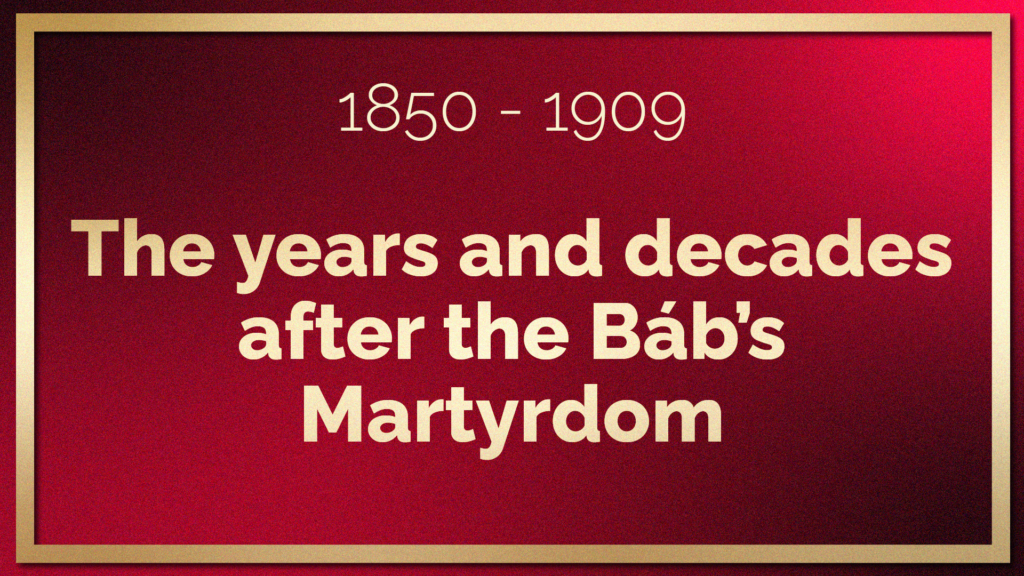
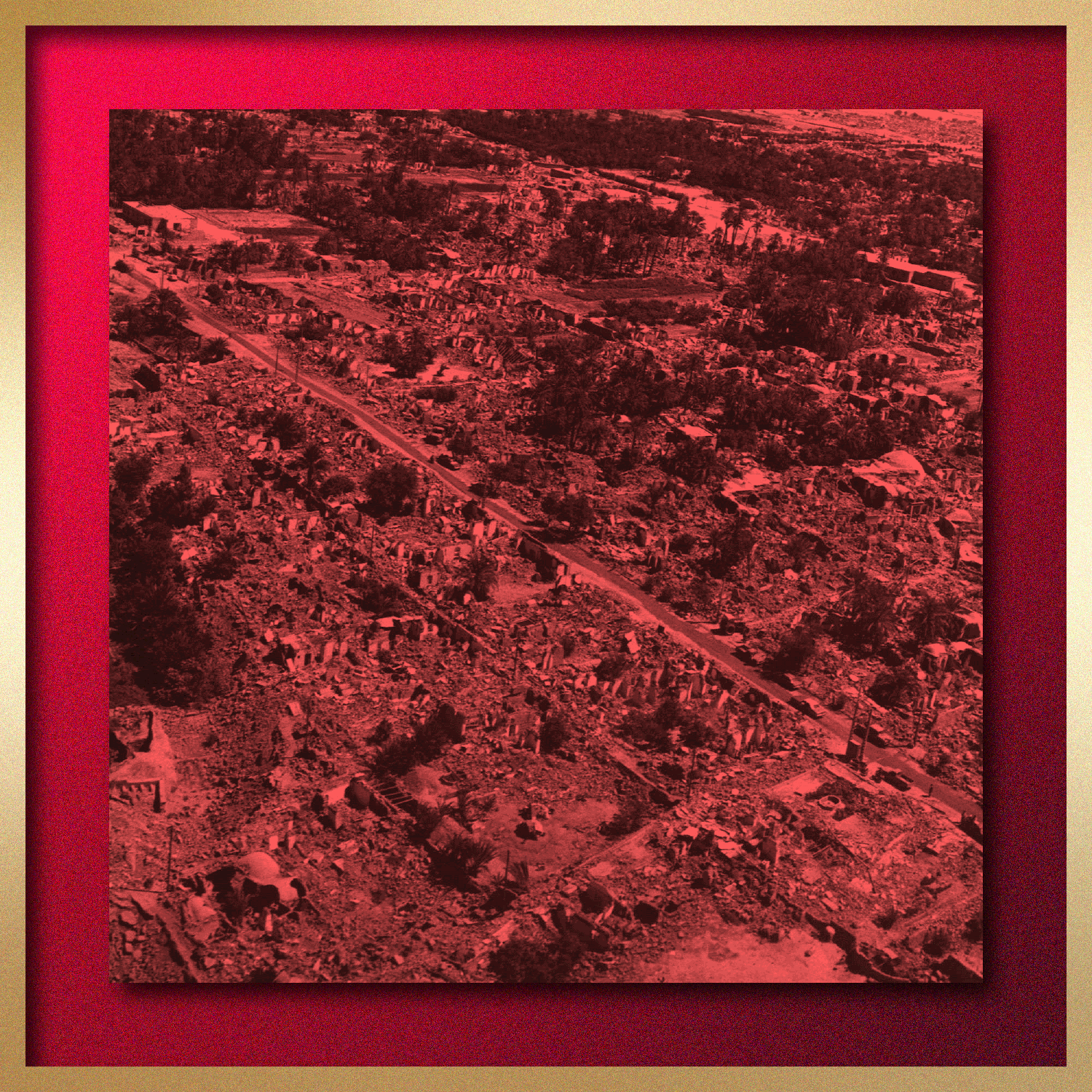
The devastation of the 1978 Tabas earthquake in the Khurasán region of Iran, as an illustration for a story about two earthquakes, divine retribution for the martyrdom of a Manifestation of God. Source: Wikimedia Commons.
“And the same hour was there a great earthquake, and the tenth part of the city fell, and in the earthquake were slain of men seven thousand: and the remnant were affrighted, and gave glory to the God of heaven. The second woe is past; and, behold, the third woe cometh quickly.”
The Bible, King James Version, Revelation Chapter XI: Verses 13-14.
'Abdu'l-Bahá confirmed in Some Answered Questions that this prophecy in the Revelation of St. John is about the Martyrdom of the Báb, and He clarified that the first woe was the advent of the Prophet Muḥammad, the second woe was the advent of the Báb and the third woe the Day of the advent of Bahá'u'lláh.
The Shaykhu’l-Islám of Tabríz, the insolent, greedy, and tyrannical Mírzá ‘Alí-Aṣghar, who had personally inflicted the torture of bastinado on the Báb after His examination in Tabríz in July 1848, was paralyzed that same year. He died a miserable, excruciating death shortly after.
Eighteen months after He banished the Báb to Ádhirbáyján in the Spring of 1847, Ḥájí Mírzá Áqásí, the Antichrist of the Bábí Revelation, lost everything. He was hurled from power, stripped of his wealth, disgraced by Naṣiri'd-Dín Sháh, forced to seek shelter in a shrine, then banished to Karbilá, where he died in 1849, diseased, penniless, and despondent.
Ḥusayn Khán, the Governor of Shíráz the first government official to publicly persecute the Báb and who had ordered Him violently struck in the face, fell from grace and watched the undoing of all his labors. He died in complete obscurity, abandoned by family and friends sometime around 1851.
His successor, Mírzá Taqí Khán, the Amír-Kabir, was directly responsible for the massacre of hundreds of Bábís in the Mázindarán Upheaval in Shaykh Ṭabarsí, the Zanján Upheaval, and the Nayríz Upheaval, causing the deaths of Quddús, Mullá Ḥusayn, and Vaḥíd. Mírzá Taqí Khán, the man who ordered the execution of the Báb, was treacherously assassinated by order of Naṣiri'd-Dín Sháh in 1852.
In 1852, 250 men from the firing squad that had martyred the Báb died in an earthquake.
Sometime between 22 April and 5 May 1853, in the Báb’s native city of Shíráz, an earthquake prophesied in the Revelation of St. John threw the whole city into a state of havoc, chaos, and turmoil made infinitely worse by the four-year cholera epidemic that had been raging through the country. 'Abdu'l-Bahá confirmed that this was the earthquake foretold in the book of Revelation, and He goes on to say that the city of Shíráz was plunged into turmoil and agitation, thousands dying as a result of the quake, cholera, famine, and starvation.
The city of Shíráz and its surrounding area in the province of Fárs was severely affected and almost all the buildings in that entire region were destroyed. The estimate of casualties ran relatively close to the prophecy from Revelation, at between 9 and 13,000 deaths.
Five years after the Báb’s martyrdom, in 1855, the remaining 500 soldiers from the firing squad were executed in the same manner as they had executed the Báb, as punishment for their mutiny.
To ensure no one had survived the execution, their bodies were riddled with a second volley of bullets, and their bodies were spiked on spears and lances and exposed for all of Tabríz to see.
The prime instigator of the Báb’s death, Mírzá Taqí Khán and his brother, his chief accomplice, died within two years of the Báb’s martyrdom.
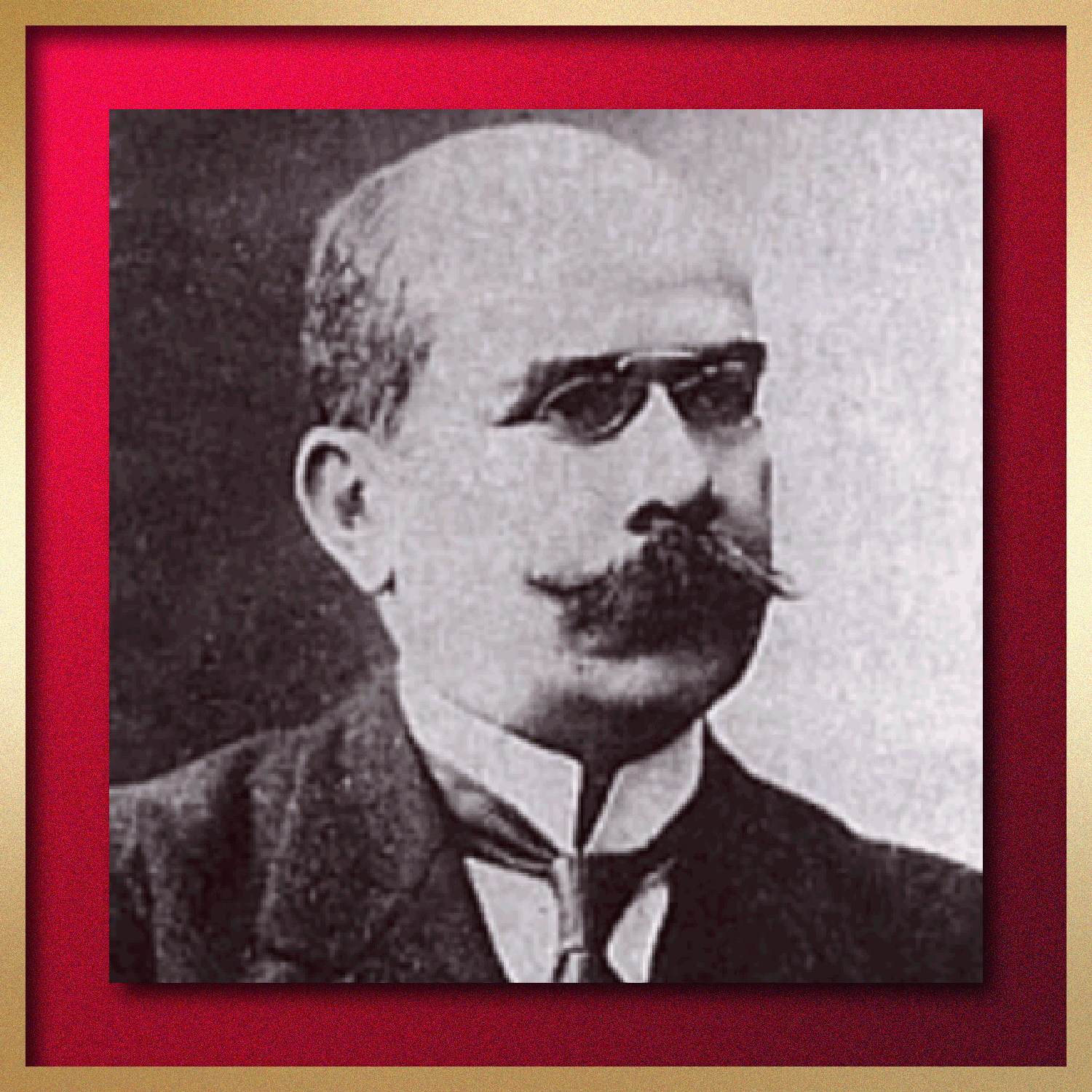
French orientalist A.L.M. Nicolas, one of the most eminent, early, and ardent admirers of the Báb is the only Western scholar this author was able to identify in the list below. Source: Wikimedia Commons.
The passage below is taken entirely from Shoghi Effendi, God Passes By:
So momentous an event could hardly fail to arouse widespread and keen interest even beyond the confines of the land in which it had occurred. This is the testimony recorded by a Christian scholar and government official, who had lived in Persia and had familiarized himself with the life and teachings of the Báb [Note: This is A.L.M. Nicolas, the French Orientalist, an early scholar of the Báb]:
“It is one of the most magnificent examples of courage every offered to humanity and an admirable proof of the love which our hero held for his fellow citizens. He sacrificed himself for humanity, offering his body and his soul, suffering privations, affronts, insults, torture and martyrdom. He sealed with his blood the pact of universal brotherhood, and like Jesus he offered his life to proclaim the reign of harmony, equity and love of one’s neighbor.”
Here is a further testimony from the pen of that same scholar commenting on the circumstances attending the Báb’s martyrdom: “A singular event, unique in the annals of mankind.”
“A veritable miracle,” is the pronouncement made by a noted French Orientalist. “A true God-man,” is the verdict of a famous British traveler and writer.
“The finest product of his country,” is the tribute paid Him by a noted French publicist.
“That Jesus of the age … a prophet, and more than a prophet,” is the judgment passed by a distinguished English divine.
“The most important religious movement since the foundation of Christianity,” is the possibility that was envisaged for the Faith the Báb had established by that far-famed Oxford scholar, the late Master of Balliol.
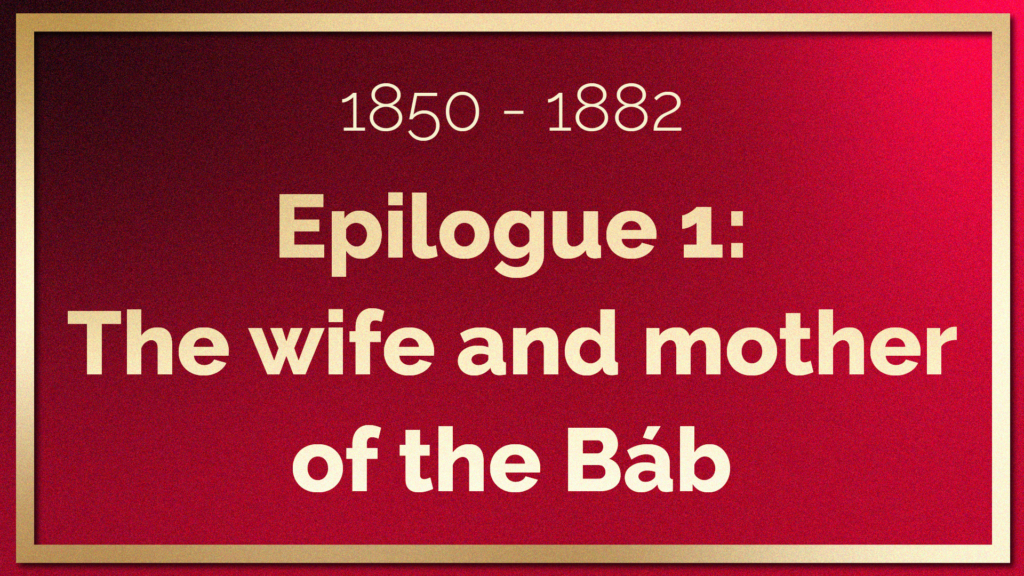
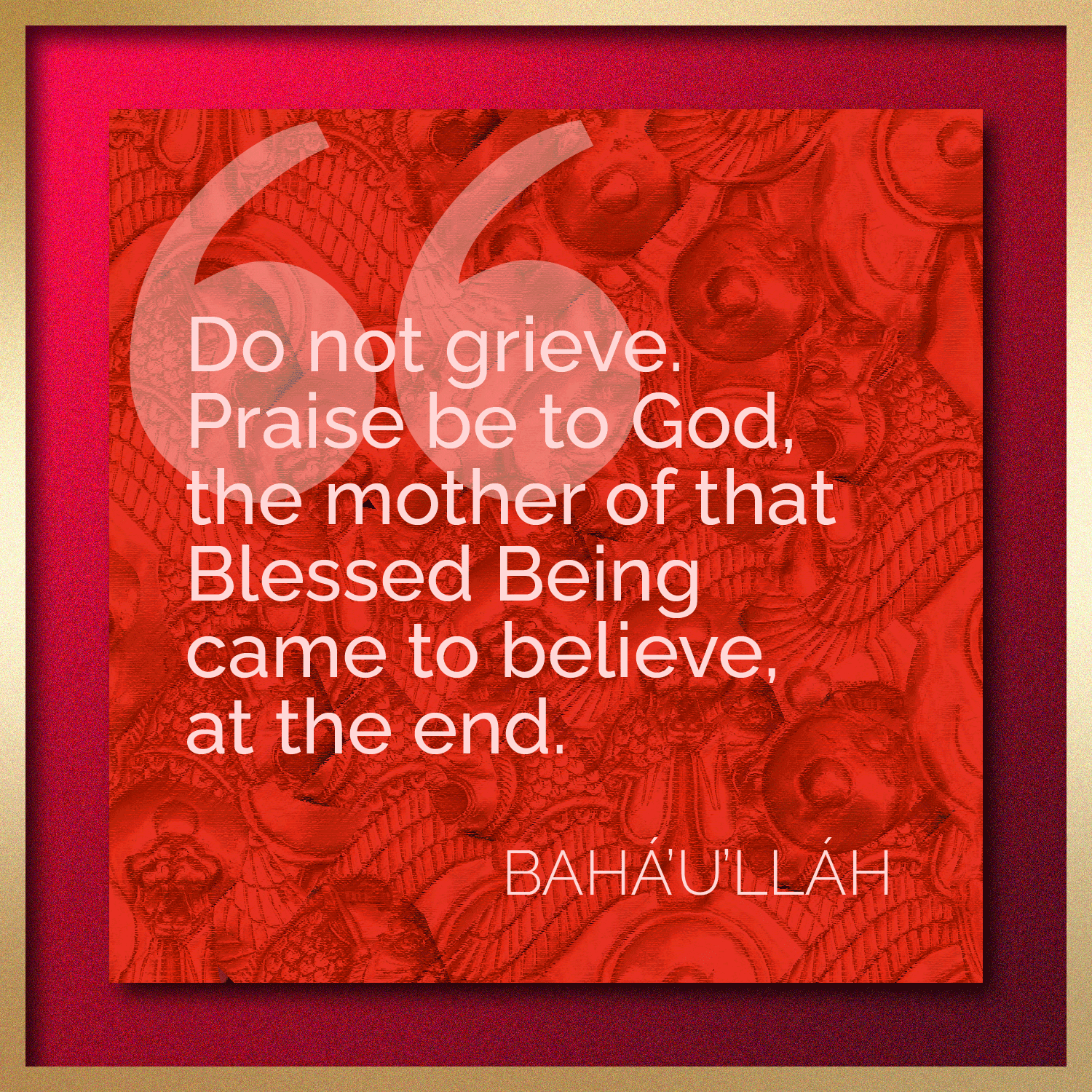
Decorated quote of the words of Bahá'u'lláh to Ḥájí Mírzá Ḥabibu’lláh Afnán. Source of the tiled/repeated background image: Gold plaque with horned lion-griffins, Achaemenid, 6th/4th century BCE from The Met. Design: © Violetta Zein
In May/June 1844, the Báb had called His mother to recognize His station in Chapter 28 of the Qayyúmu’l-Asmá’:
“O thou Mother of the Remembrance! May the peace and salutation of God rest upon thee. Indeed thou hast endured patiently in Him Who is the sublime Self of God. Recognize then the station of thy Son Who is none other than the mighty Word of God”
His summons would go unanswered for over a decade.
In 1854, 10 years after the Báb’s Declaration and 4 years after His martyrdom, Fáṭimih Bagum left Shíráz for 'Iráq.
She was inconsolable after the loss of her only Son, and her relatives were cruel, spiteful, hostile, so she left to live out the rest of her days in the ‘Atabát the Báb had so loved, near the Shí’ah Holy Shrines.
Fáṭimih Bagum moved to Najaf, 145 kilometers (90 miles) from Baghdád, where she lived a life of seclusion, prayer, and meditation.
After Bahá'u'lláh had returned from His self-imposed retirement in Sulaymáníyyih, Kurdistán, in March 1856, He took a deep personal interest in the Báb’s grieving mother, and sent two devoted Bábís to Najaf to acquaint her with her Son’s station as a Manifestation of God and instruct her in the principles of the Bábí Faith.
The believers Bahá'u'lláh chose for this important mission were well known to Fáṭimih Bagum. One was Ḥájí Siyyid Javad-i-Karbilá'í, who had been a close friend of the Báb’s maternal uncle and had known the Báb since He was a five-year-old boy (see Part I). The other was the wife of Ḥájí 'Abdu'l-Majíd-i-Shírází. They were patient, and kind, and helped her surmount the obstacles that prevented her from embracing the Bábí Faith.
It is entirely thanks to Bahá'u'lláh’s care and loving kindness for the mother of His Herald, the Báb, that in the end, Fáṭimih Bagum not only embraced the Bábí Faith but died fully aware of the station of her blessed Son. Fáṭimih Bagum passed away the same year as her daughter-in-law Khadíjih Bagum, in 1882.
Years later, Bahá'u'lláh received Ḥájí Mírzá Ḥabibu’lláh Afnán, a member of the Báb’s family on pilgrimage, and Bahá'u'lláh spoke of Fáṭimih Bagum’s conversion in 'Iráq, decades earlier. After recounting the sad story of her difficulties, Bahá'u'lláh turned to the Afnán and told him:
“Do not grieve. Praise be to God, the mother of that Blessed Being came to believe, at the end.”
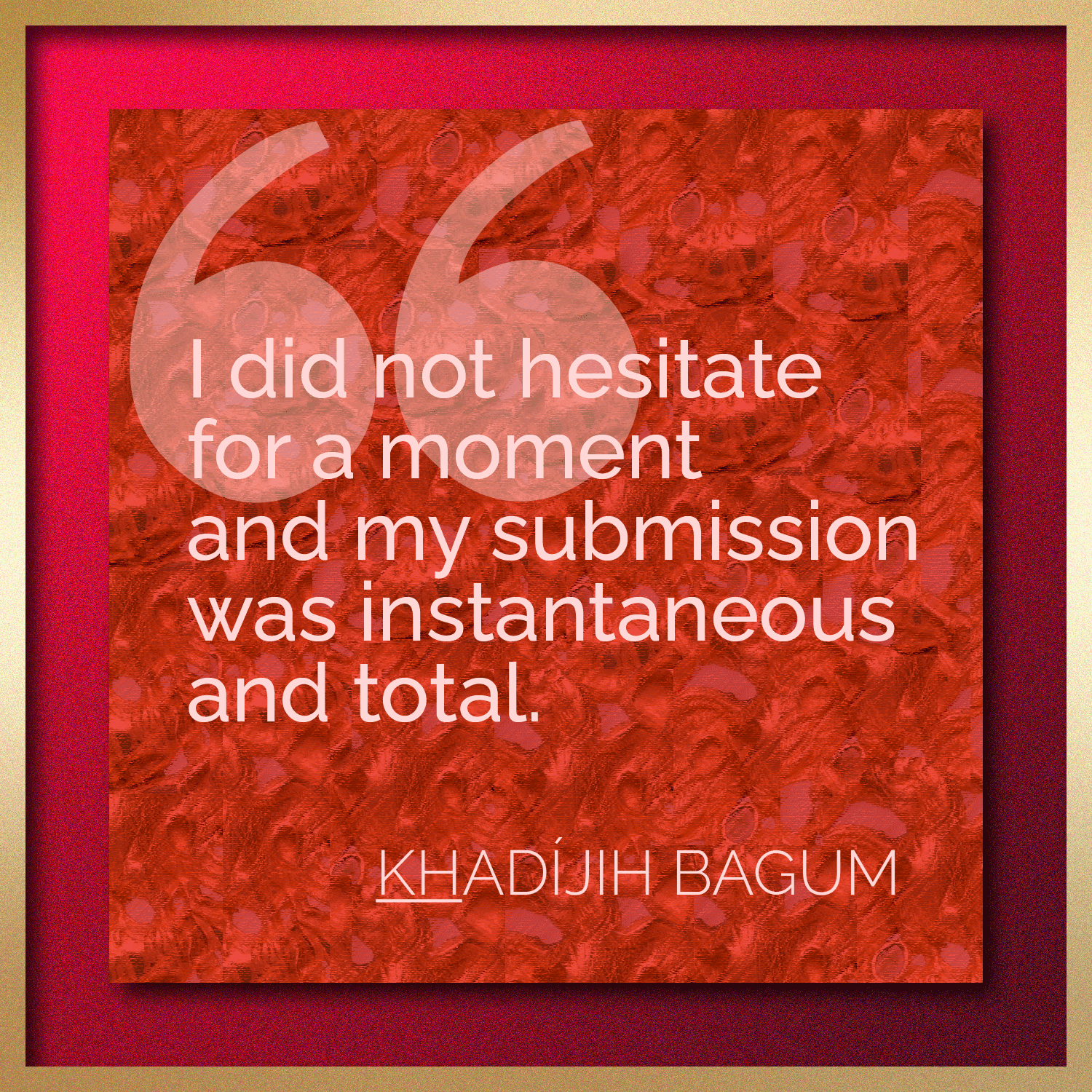
Decorated quote of the words of Khadíjih Bagum regarding her recognition of Bahá'u'lláh. Source of the tiled/repeated background image: Gold belt adornment with an eagle and its prey Parthian or Kushan 1st/2nd century CE from The Met. Design: © Violetta Zein
The last time Khadíjih Bagum ever saw her beloved Husband was the night of 23 September 1846, when the constable of Shíráz, ‘Abdu'l-Hamíd Khán and his men entered Ḥájí Mírzá Siyyid ‘Alí’s’ house through the roof and took the Báb away.
Khadíjih Bagum and Fáṭimih Bagum were not immediately informed of His martyrdom. The years following the Báb’s execution were tumultuous years in Persia and for the Bábí community, and Khadíjih Bagum played an important role in offering comfort to the women of the community, particularly to the widows of the martyrs of the Nayríz Upheaval.
Khadíjih Bagum was an active and effective teacher of the Faith. It was thanks to her that her 13-year-old nephew, Áqá Mírzá Áqá became one of Bahá'u'lláh’s foremost disciples. Ḥájí Mírzá Ḥabibu’lláh Afnán, who was speaking to Bahá'u'lláh about Fáṭimih Bagum in the previous story was his son.
After Bahá'u'lláh’s Declaration in Baghdád in April 1863, He sent Nabíl on several Proclamation journeys to Persia. On one of these occasions, Nabíl was traveling through Shíráz and he stopped to visit the widow of the Báb.
As soon as Khadíjih Bagum heard Nabíl say that Bahá'u'lláh was “Him Whom God shall make manifest,” she believed. She instantly knew that Bahá'u'lláh was the One whose advent the Báb had announced, simply hearing His name. For the second time in her life, she experienced that feeling of spiritual radiance she had felt when she stood in front of the Báb in a state of Revelation.
She was so overcome, she could only manage a whisper to Nabíl:
“Offer at His sacred threshold my most humble devotion.”
When Munírih Khánum visited her on the way to the Holy Land where she would marry 'Abdu'l-Bahá, Khadíjih Bagum remembered that day where she became a Bahá'í:
“I did not hesitate for a moment and my submission was instantaneous and total.”
For the last 20 years of her life, Khadíjih Bagum stayed in close contact with Bahá'u'lláh and wrote Him many letters, asked Him for advice and help on making decisions.
Ten years before she passed away, Khadíjih Bagum sent Munírih Khánum to the Holy Land with three requests for Bahá'u'lláh. The first was that she longed for the house of the Báb to be repaired so she could live in it again. The second was for the families of the Báb and Bahá'u'lláh to be united in marriage. She specifically asked if Bahá'u'lláh would consent for His daughter Furúghíyyih Khánum to marry the Báb’s nephew, Ḥájí Siyyid ‘Alí. Her third request was a permission for pilgrimage, so that she might finally meet Bahá'u'lláh in person, and meet Ásíyih Khánum, with whom she shared the honor of being the consort of a Manifestation of God. The two women had for decades longed to meet each other.
Bahá'u'lláh granted all three of her requests.
As for the first request, Khadíjih Bagum was able to live in the house of the Báb after some repairs were made.
The second and third requests were linked, the idea being that Khadíjih Bagum would have traveled with her brother, and nephew to the Holy Land to formalize Ḥájí Siyyid ‘Alí’s, engagement to Furúghíyyih Khánum, and on the same occasion she would go on her long-desired pilgrimage to meet Bahá'u'lláh.
The end of Khadíjih Bagum’s life was filled with sorrow and heartbreak.
Her brother, his wife, her nephew and niece all traveled together directly from Yazd to the Holy Land to formalize the engagement and they did not inform Khadíjih Bagum or offer to bring her with them.
The emotional blow of this betrayal shattered Khadíjih Bagum and broke her. Nothing could comfort her, and she cried tears of anguish. The grief tore her delicate being apart, emotionally, and physically. She lost hope of ever seeing Bahá'u'lláh on this earthly plane and lost the will to live. She fell ill and never recovered.
Khadíjih Bagum died in 1882, having survived the Báb by 32 years.
Two hours after she died, Fiḍḍih, the Ethiopian woman who had been by her side since she first married the Báb 40 years ago, also died.
News of Khadíjih Bagum’s passing broke Bahá'u'lláh’s heart, especially the cruel betrayal that preceded. Ásíyih Khánum, His wife, was inconsolable, as she had treasured the idea of meeting Khadíjih Bagum.
Bahá'u'lláh revealed many Tablets of visitation in her honor which attest to the depth of His sorry and grief. He called her death “a great calamity which had caused the inhabitants of the highest Heaven and most lofty Paradise to lament” and described His own grief as escribing it as a “sorrow, like unto the life-vein, coursed throughout the body and in every artery produced its effect.”
Bahá'u'lláh revealed the epitaph for Khadíjih Bagum’s tomb:
“He is the Eternal! Verily, the exalted leaf hath heard the call of the divine Lote-Tree and hath taken her flight unto it. 1299 [1882].”
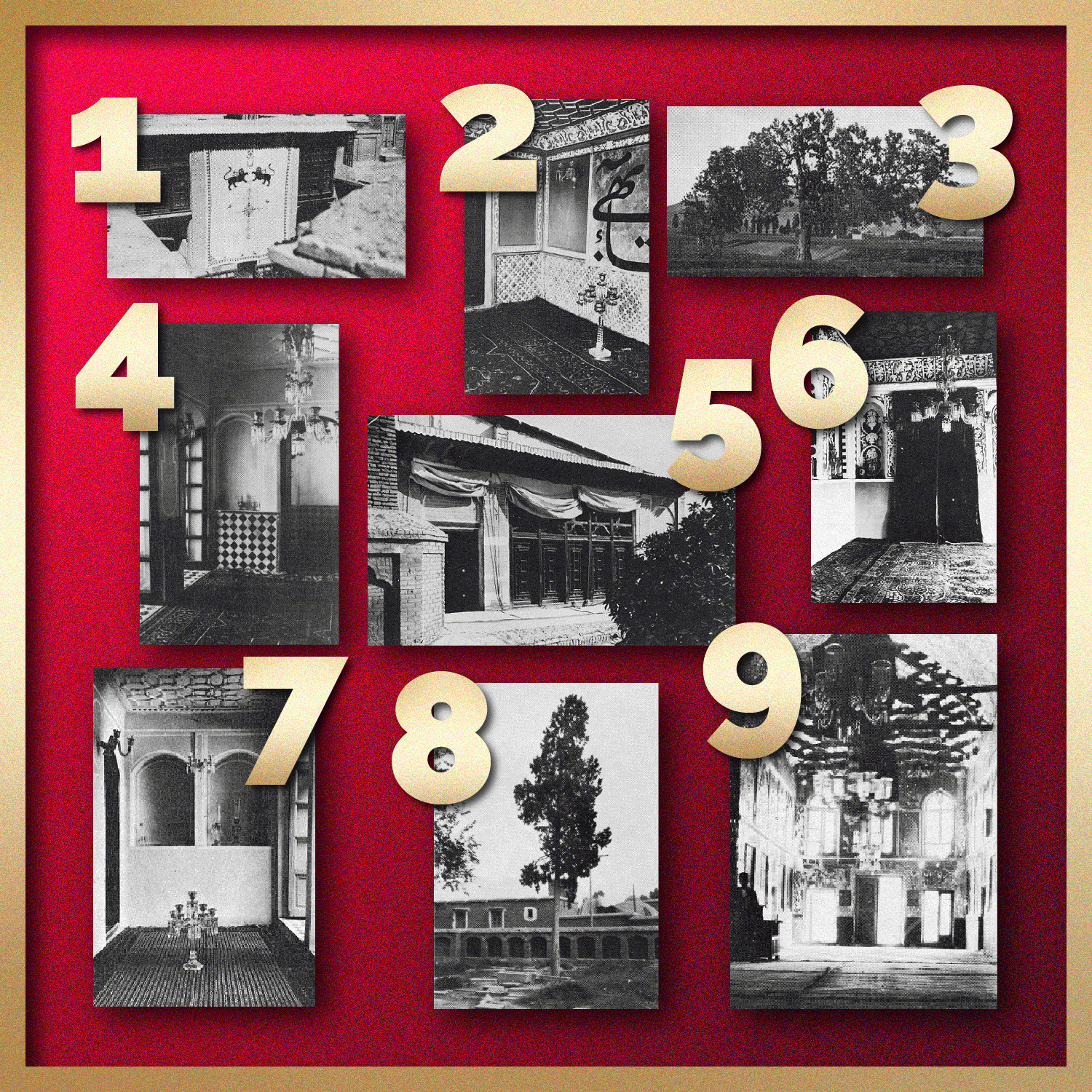
“Khadíjih Bagúm: Wife and martyr”: A collage of nine images symbolic of the shared lives of the Báb and Khadíjih Bagúm. © Violetta Zein Photo 1: The room on the left is where the Báb was born in Shíráz. Photo 2: The room of the Báb’s mother. Photo 3: Outskirts of Shíráz where the Báb often went to walk. Photo 4: the Báb’s sitting room. Photo 5: Outside view of the upper floor room where the Báb declared His mission to Mullá Ḥusayn. Photo 6: Inside view of the Declaration chamber. Photo 7: The Báb’s sitting room. Photo 8: Tree marking resting place of the Báb's infant son in Bábí-Dukhtarán, Shíráz. Photo 9: Grave of the Báb's wife in Sháh-Chiragh, Shíráz. Source for photos: Nabíl, The Dawn-Breakers, pages 58, 60, 61, and 75.
Khadíjih Bagum, was a lineal descendent of Khadíjih, the wife of the Prophet Muḥammad. Her illustrious ancestor is considered the first Muslim, as she was the first to believe in the Prophet Muḥammad as a Manifestation of God.
Thirteen centuries later, Khadíjih Bagum, descendent of Khadíjih, was also married to a Manifestation of God.
And, like Khadíjih, Khadíjih Bagum would be the first person to recognize the Divine station of her Husband—Himself the direct descendent of the Prophet Muḥammad.
This fact was confirmed by Bahá'u'lláh, Who affirmed that she “found the fragrance of the garment of the Merciful” “before the creation of the world of being.”
In a Tablet revealed a year after her passing, Bahá'u'lláh elevated Khadíjih Bagum to the rank of martyr, the only female martyr in the family of the Báb:
“The heart of Thamariy-i 'Ulyá (the Most Exalted Fruit) was verily consumed in the fire of separation. For that reason, before God she is regarded as a martyr.”
The degree of Khadijih Bagum's faith and the rank she attained are attested by Nabil:
“The wife of the Báb...perceived at the earliest dawn of His Revelation the glory and uniqueness of His Mission and felt from the very beginning the intensity of its force. No one except Tahirih, among the women of her generation, surpassed her in the spontaneous character of her devotion nor excelled the fervour of her faith.”
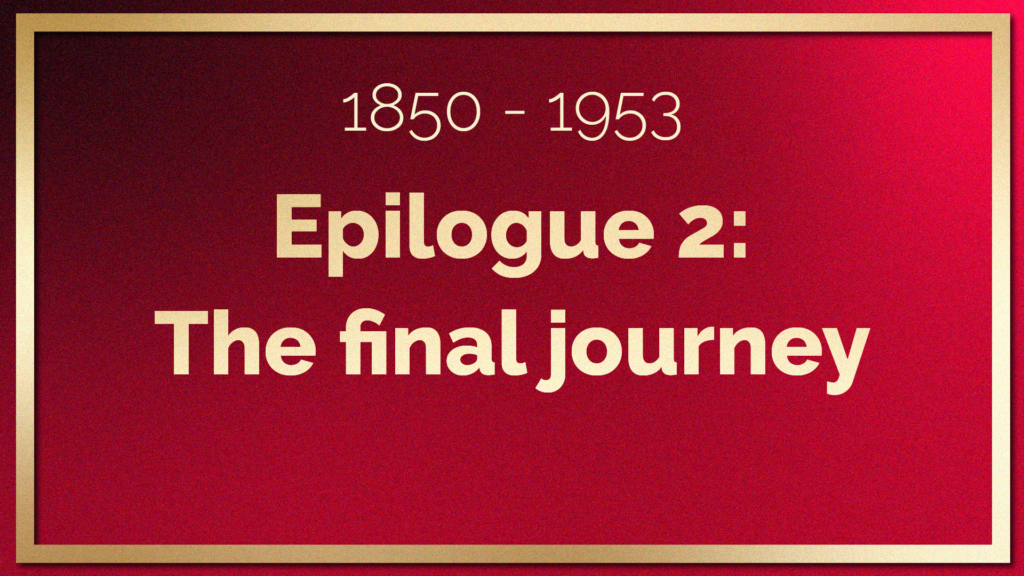
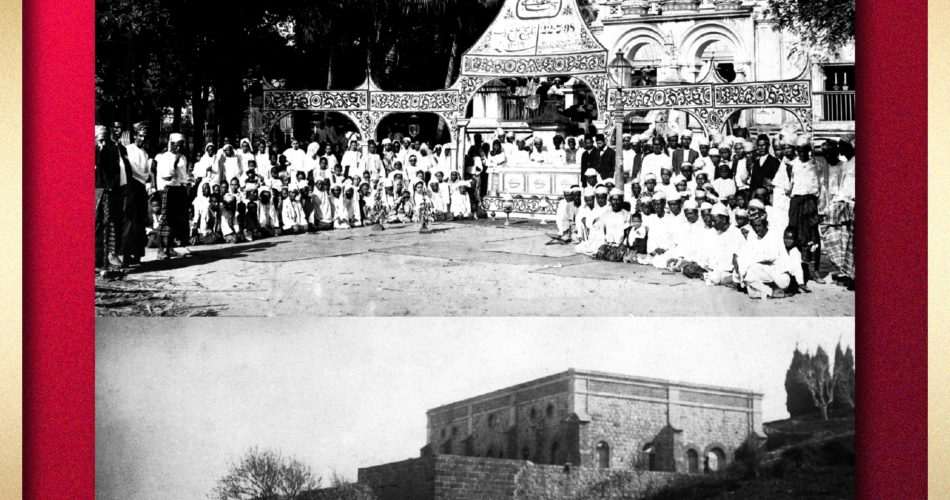
Top photograph: The Bahá'ís of Burma with the completed sarcophagus before it was shipped to 'Abdu'l-Bahá. The gilded carved calligraphy inscriptions by Mishkín-Qalam are visible on the sides of the sarcophagus. Source: Bahá'í Media Bank,© Bahá'í International Community 2023. Bottom photograph: The Shrine of the Báb, completed by 'Abdu'l-Bahá in the early 1900s. Source: Bahá'í Media Bank, © Bahá'í International Community 2023
On 11 July 1850, a casket was built to protect the remains and send them to Ṭihrán where Bahá'u'lláh would ensure their safekeeping, with immense discretion, and in extremely delicate and dangerous circumstances for a period of 44 years.
In 1894, two years after the Ascension of Bahá'u'lláh, 'Abdu'l-Bahá initiated the beginning of their transfer to the Holy Land, to their final resting place on Mount Carmel, a spot indicated to Him by Bahá'u'lláh the summer before He passed away. It would take 5 years of careful planning for 'Abdu'l-Bahá to safely bring the holy remains of the Báb to the Holy Land, and another 10 years for him to build a befitting Shrine to inter them.
'Abdu'l-Bahá had erected the Shrine at tremendous personal cost, stone by stone, at a distance from 'Akká, where He was still a prisoner. He had safeguarded the sacred remains of the Báb for ten years in several secret locations. The precious Burmese wood coffin meant to hold the box of the Báb’s holy dust and the exquisite marble sarcophagus that had been built in Burma according to His specific detailed instructions, with gold illuminated carvings of verses along the side, had been ready and waiting, hidden in Haifa for a decade.
'Abdu'l-Bahá Himself recounted the trials He had to overcome to complete this task, one of the three objectives He had set Himself for His ministry:
“Every stone of that building, every stone of the road leading to it, I have with infinite tears and at tremendous cost, raised and placed in position. One night I was so hemmed in by My anxieties that I had no other recourse than to recite and repeat over and over again a prayer of the Bab which I had in My possession, the recital of which greatly calmed Me. The next morning the owner of the plot himself came to Me, apologized and begged Me to purchase the property.”
On 21 March 1909, at long last, the time had come.
By the light of a single lamp, 'Abdu'l-Bahá removed His turban. His shoes and His dark outer cloak. Bareheaded and barefoot, in simple white garments, Abdu’l-Bahá descended into the vault, and placed the original wooden casket containing the sacred remains of the Báb and Anís into the wooden coffin inside the marble sarcophagus.
Then, 'Abdu'l-Bahá bent low over the casket and wept with such a weeping that the people present could not withhold their tears, and cried with Him.
'Abdu'l-Bahá secured the ebony lid of the coffin, and closed the marble lid of the sarcophagus, forever safeguarding its holy trust, then chanted the prayer for the dead. Fifty-nine long years after His Martyrdom, the Báb was laid to rest at His final resting place.
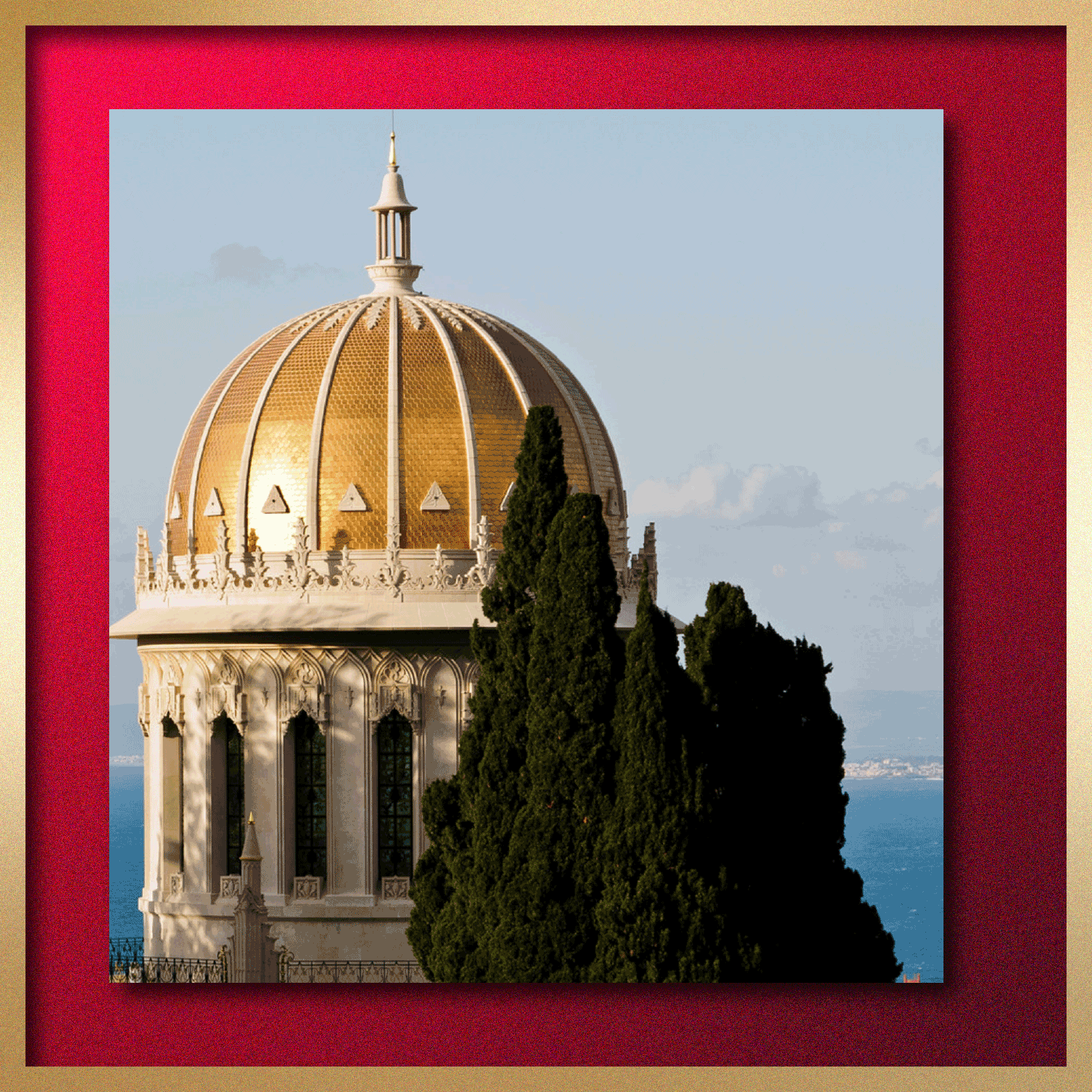
The superstructure of the Shrine of the Báb in Haifa, Israel, built by Shoghi Effendi. © Chad Mauger, all rights reserved, used with permission. Source: Flickr.
In 1953, when Shoghi Effendi completed the jewel-like superstructure of the Shrine of the Báb, the Báb’s mausoleum was bathed in light upon light, streaming out of the stained-glass windows. When the Báb had first arrived in Máh-Kú, His cell was dark, and He had been deprived of even a candle. Now, forever more, His sepulcher would radiate light from the heart of Mount Carmel, seen in every direction, a beacon of beauty, a sign of hope, a reminder that nothing could ever stop the light He had Himself brought into the world.
On 29 April 1953, the 100th Ninth Day of Riḍván in Bahá'í history, the 56-year-old Shoghi Effendi climbed the scaffolding at the base of the dome of the Shrine, and reverently placed a small silver box containing a fragment of plaster from the ceiling of the Báb’s cell in the castle of Máh-Kú beneath one of the gold tiles in the first row around the dome.
On 7 October 1953, at the end of the Holy Year, Shoghi Effendi left an immortal, eloquent description of the finally completed Shrine of the Báb:
“A steadily swelling throng of visitors from far and near, on many days exceeding a thousand, is flocking to the gates leading to the Inner Sanctuary of this majestic mausoleum; paying homage to the Queen of Carmel enthroned on God’s Mountain, crowned in glowing gold, robed in shimmering white, girdled in emerald green, enchanting every eye from air, sea, plain and hill.”
To continue the story of the heroic age of the Faith, please follow the link below to the chronology of the life of Bahá’u’lláh: The Blessed Beauty Part 2: The birth of the Bahá’í Faith (1844 – 1853) which continues where the Primal Point ends:
REFERENCES FOR PART XI
Mírzá Taqí Khán orders the execution of the Báb
H.M. Balyuzi, The Báb: The Herald of the Day of Days, pages 152-153.
Nabil, The Dawn-Breakers, page 504.
19 June 1850: The Báb arrives in Tabríz
H.M. Balyuzi, The Báb: The Herald of the Day of Days, pages 152-153.
Nabil, The Dawn-Breakers, page 504.
Abbas Amanat, Resurrection and Renewal: The Making of the Bábí Movement in Iran (1844-1850), page 396.
8 July 1850: Anís begs to be martyred with the Báb
H.M. Balyuzi, The Báb: The Herald of the Day of Days, pages 153-154.
Nabil, The Dawn-Breakers, Chapter XXIII: The Martyrdom of the Báb.
The night of 8 July 1850: The Báb asks His companions to kill Him
H.M. Balyuzi, The Báb: The Herald of the Day of Days, pages 154-155.
Nabil, The Dawn-Breakers, Chapter XXIII: The Martyrdom of the Báb.
H.M. Balyuzi, The Báb: The Herald of the Day of Days, pages 155-157.
Shoghi Effendi, God Passes By.
Nabil, The Dawn-Breakers, Chapter XXIII: The Martyrdom of the Báb.
Abbas Amanat, Resurrection and Renewal: The Making of the Bábí Movement in Iran (1844-1850), pages 399-400.
Two hours before noon on 9 July 1850: The first attempt to execute the Báb
H.M. Balyuzi, The Báb: The Herald of the Day of Days, page 157.
Nabil, The Dawn-Breakers, Chapter XXIII: The Martyrdom of the Báb.
Abbas Amanat, Resurrection and Renewal: The Making of the Bábí Movement in Iran (1844-1850), page 403.
J.E. Esslemont, Bahá’u’lláh and the New Era.
Fereydun Vahman (Editor),The Bab and the Babi Community of Iran (2020), Chapter 1: The Báb: A Sun in a Night Not Followed by Dawn by Fereydun Vahman.
Immediately after: The Báb in conversation with His amanuensis
H.M. Balyuzi, The Báb: The Herald of the Day of Days, pages 157-158.
Noon on 9 July 1850: The Báb addresses the crowd
H.M. Balyuzi, The Báb: The Herald of the Day of Days, page 158.
Nabil, The Dawn-Breakers, Chapter XXIII: The Martyrdom of the Báb.
J.E. Esslemont, Bahá’u’lláh and the New Era.
H.M. Balyuzi, The Báb: The Herald of the Day of Days, page 158.
Nabil, The Dawn-Breakers, Chapter XXIII: The Martyrdom of the Báb.
The connection between Jesus Christ and the Báb
H.M. Balyuzi, The Báb: The Herald of the Day of Days, pages 158-159.
The afternoon and evening of 9 July 1850
H.M. Balyuzi, The Báb: The Herald of the Day of Days, pages 158-159.
Nabil, The Dawn-Breakers, Chapter XXIII: The Martyrdom of the Báb.
Shoghi Effendi, God Passes By.
The morning of 10 July 1850: The sketch of the Báb’s remains
Nabil, The Dawn-Breakers, page 518.
11 July 1850: The retrieval of the remains of the Báb
H.M. Balyuzi, The Báb: The Herald of the Day of Days, pages 159-160.
1848 – 1855: “The rod of Divine chastisement”: The fate of the Báb’s enemies
Shoghi Effendi, God Passes By and excerpt 2.
Wikipedia: 1853 Shiraz earthquake.
Wikipedia: Amir Kabir.
Wikipedia: Haji Mirza Aqasi.
Moojan Momen, The Bábí and Bahá’í Religions, 1844 – 1941: Some Contemporary Western Accounts, page 171.
Western testimonies of the martyrdom of the Báb
Shoghi Effendi, God Passes By.
1850 – 1882: Fáṭimih Bagum, the mother of the Báb
Nabíl, The Dawn-Breakers, pages 190-193.
Baharieh Rouhani Ma’ani, Leaves of the Twin Divine Trees, pages 4-22.
1850 – 1882: Khadíjih Bagum, the wife of the Báb
Baharieh Rouhani Ma’ani, Leaves of the Twin Divine Trees, pages 26-60 and 114.
Adib Taherzadeh, The Revelation of Bahá’u’lláh Volume 2: Adrianople 1863-1868, pages 381-387.
1850 – 1909: The final journey of the remains of the Báb Part I: The ministry of ‘Abdu’l-Bahá
H.M. Balyuzi, The Báb: The Herald of the Day of Days, pages 159-160.
Shoghi Effendi. God Passes By.
Adib Taherzadeh, The Covenant of Baha’u’llah, Chapter 19: Building the Shrine of the Báb.
1921 – 1953: The final journey of the remains of the Báb Part II: The ministry of Shoghi Effendi
H.M. Balyuzi, The Báb: The Herald of the Day of Days, pages 159-160.
Shoghi Effendi. God Passes By.
Adib Taherzadeh, The Covenant of Baha’u’llah, Chapter 19: Building the Shrine of the Báb.
Ugo Giachery Oxford, Shoghi Effendi: Recollections, Chapter VII: The Superstructure of the Shrine of the Báb, Section 4: The Crown and the Dome.
Khadíjih Bagum: Only female martyr in the family of the Báb
Baharieh Rouhani Ma’ani, Leaves of the Twin Divine Trees, pages 55-58.
H.M. Balyuzi, Khadíjih Bagum, The Wife of the Báb, page 14.
Adib Taherzadeh, The Revelation of Bahá’u’lláh Volume 2: Adrianople 1863-1868, pages 381-387.
 Mírzá Taqí Khán orders the execution of the Báb
Mírzá Taqí Khán orders the execution of the Báb
